California Has a Critical Shortage of Black Teachers
Black Leaders Say Threats to Undermine US Democracy Appear Aimed at Blacks
BY AYANNA ALEXANDER Associated PressMedia
By Antonio Ray Harvey California BlackNumerous studies have shown that Black teachers can improve Black students’ academic outcomes, but in California, where Black Students are the lowest performing sub-group of all ethnic groups, the state has an extremely low count of African American instructors working in school districts across the state
According to the California Department of Education’s 2018-2019 Ethnic Distribution of Public-School Teachers, Black teachers disproportionately make up 3.8% of the state’s 12,000 public school classroom instructors.
Blacks account for about 5.7% of California’s total population of almost 40 million people.
“Addressing the educator shortage is one of the most important things we can do to support student achievement,” stated Tony Thurmond, the state’s Superintendent of Public Instruction.
“We must increase compensation, prioritize training, improve working conditions, and pursue all strategies that can help our schools add staff to help our students thrive,” Thurmond continued.
Thurmond made this assessment at a news conference before he hosted a Teacher Recruitment Summit at the California Department of Education (CDE) in Sacramento last month.
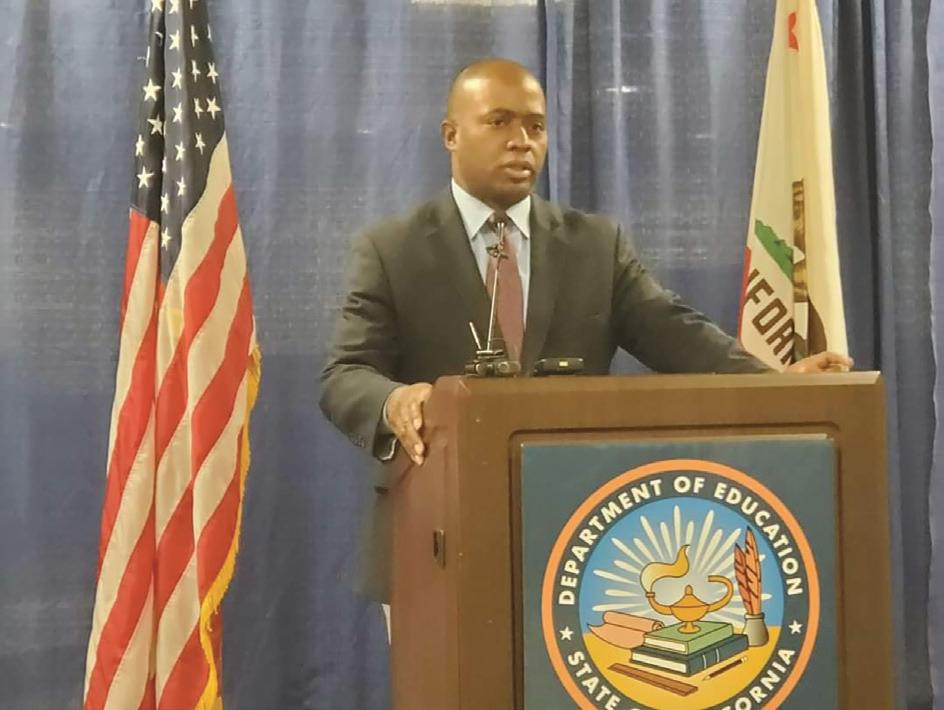
The Teacher Recruitment Summit was opened to individuals from all organizations focused on reducing the teacher shortage. The event formally launched a coalition to engage in direct recruitment of teacher candidates statewide,
The summit included information about teacher credentialing programs affiliated with school districts and county offices of education, pipeline programs, and AmeriCorps programs.
CDE is addressing the needs of Black educators but there some people who found channels to enter the profession outside of the traditional process, including Nisha Britton who is employed at Angelo Rodriguez High School in Northern California.
Britton, 37, is a Special Education specialist at the school located in Fairfield, 45 east of San Francisco. She just started her first year working with special education students where there are about five Black teachers among the faculty.
Britton, who has a bachelor’s degree in communications/Journalism from Morgan State University -- a Historically Black College and University (HBCU) in Maryland -- says she is aware about the shortage of Black teachers in the state. She’s motivated to combat the issue on multiple levels.
“There is a lot of diversity at this school, but I feel like these kids need someone like me,” Britton told California Black Media (CBM). “I want to help these kids figure out what they want out of life.”
Angelo Rodriguez High School opened in 2001 and is the newest of the three comprehensive high schools in Fairfield-Suisun Unified School District. Angelo Rodriguez High School is located in Fairfield.
Britton is not fully certified as an educator. She found a pathway through the California Commission on Teacher Credentialing program (CTC) which certifies her for two years. CTC is committed to ensuring the integrity, relevance, and high quality in the preparation, certification,
The California Department of Education held a teacher recruitment summit in Sacramento. Members of organizations focused on direct recruitment of teacher candidates and credentialing programs attended the event held on Aug. 14. (CBM Photo by Antonio Ray Harvey)
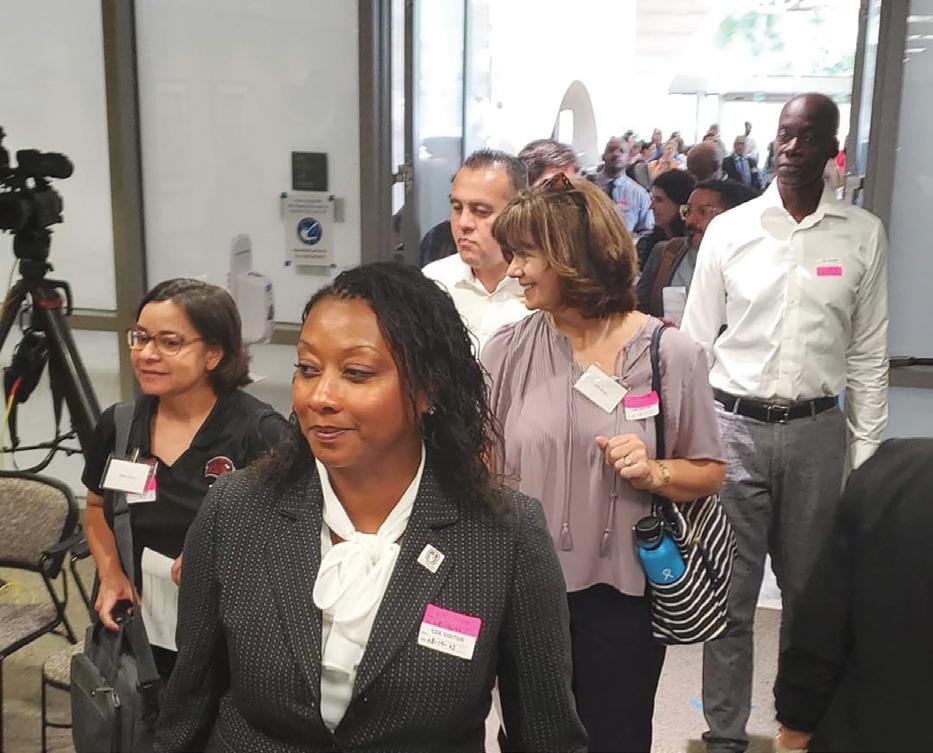
an effort to recruit teachers
news conference. Through his extensive research, Bristol has been at the forefront of increasing Black male participation in public school education. According to the U.S. Department of Education’s the State of Racial Diversity in the Educator Workforce,” educators of color account for less than 10% of all public-school teachers across the country. Black males represent 1.9% of that total.
Based on CDE’s 2018-2019 figures, Black male teachers in California accounted for one percent (3705) of 307,470 instructors in the state. The student population in the state was 6,186,278 during the last school year.
While doing research in Boston, Bristol discovered that Black male educators had one of the highest rates of turnover. Most of them left the profession due to poor working environments, feelings of isolation and the perception that they are the overseers of problematic students rather than educators, and the inability to receive adequate tools from school administrators.
WASHINGTON (AP) –– Some of the nation’s most influential Black leaders on Thursday said many threats to democratic institutions in the U.S. appear to be aimed squarely at their community, including efforts to make voting more difficult, censor lessons around race and weaken social safeguards such as affirmative action.
They used a wide-ranging forum at the annual meeting of the Congressional Black Caucus Foundation as a call to action to ensure that the interests of Black Americans are not further eroded.
“The attacks on our democracy are happening on all fronts,” said Nicole Austin- Hillery, president & CEO of the foundation. She said they are grounded in “a racist view of America, and they all depend on misinformation and often downright deceit.”
Several members of the Black Caucus, along with voting rights advocates and community activists spoke about how mostly Republican-led actions to dismantle affirmative action in higher education, ban books in schools and restrict voting are particularly harming Black Americans.
As one example, they referred to the state and local controversies over critical race theory, an academic concept centered on the notion that racism is inherent in the country’s institutions. It has become a familiar talking point for Republican lawmakers across the country as they have restricted how race can be taught _ even though there is little evidence that critical race theory is being taught in K-12 schools.
Kimberlé W. Crenshaw, a law professor who helped develop the concept, said it was part of a widespread attack on Black history, wisdom and knowledge.
“We have to recognize that what we’re fighting for right now is not just the next election or the election after that,” she said. “We’re fighting for our right to be here for the rest of this century and beyond.”
The Congressional Black Caucus Foundation said 18 states have limited how race can be taught. Florida, whose governor, Ron DeSants, is running for the GOP presidential nomination, has made headlines around its efforts to curb how schools teach about race and to block Advanced Placement courses on African American studies.
Several speakers also criticized the U.S. Supreme Court’s decision earlier this year ending affirmative action in college admissions. That is forcing campuses to look for new ways to diversify their student bodies.
At Dominguez High School in Compton, University of California Berkeley professor Dr. Travis Bristol moderates a discussion about equipping Black teachers with the resources they need to be successful in the classroom. Photo: Courtesy of Travis Bristol.
and discipline of the educators who serve the state’s diverse students, according to the organization’s website.
There were more than 10,000 teacher vacancies across California during the 2020-2021 school year. The state has allocated $3.6 billion in funding over the last four years to improve recruitment, training, and retention.
Dr. Travis Bristol, Associate Professor of Teacher Education and Education Policy at Berkeley School of Education, was one of the guest speakers at Thurmond’s
Bristol and other Black educators have facilitated professional learning networks across the state where Black male teachers can discuss their challenges. s.
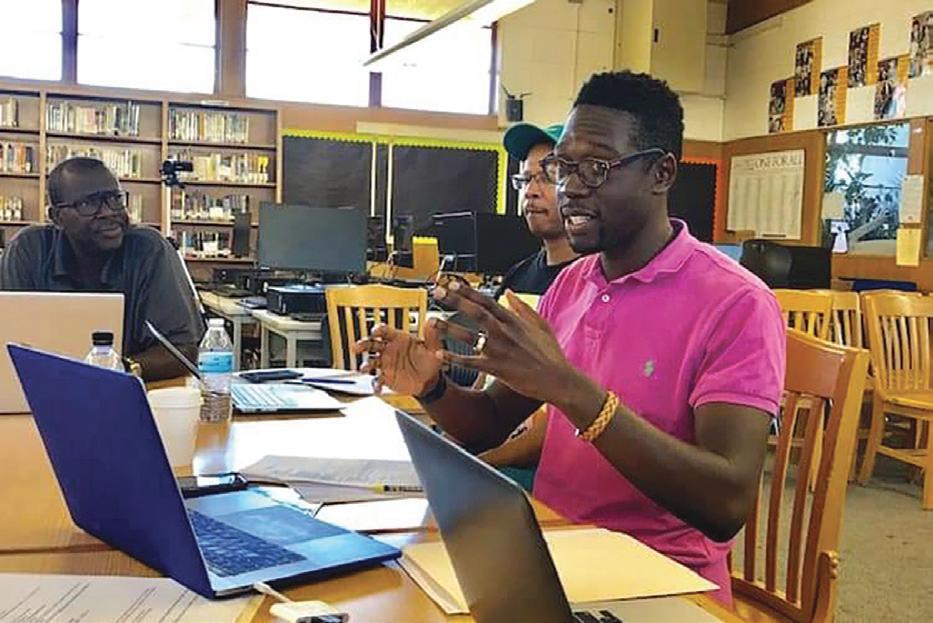
Bristol, who majored in English as an undergrad at Amherst College, expressed gratitude and urged caution in recruitment, saying that there are other “critical issues” as to why there is a low count of Black men and women educators. The UC Berkeley professor said he does not advocate for a “replacement theory.” White students perform well academically and benefit from having Black teachers, too.
“The research and evidence is are clear that when students of color have a teacher of color they persist in school They are less likely to get suspended, and have higher achievement,” Bristol said. “But as we spend some time thinking about recruitment, let us not lose sight of thinking about and pushing for recruitment, supporting and sustaining ethnic racial diversity in the workforce.”
Dr. King’s Economic Justice Movement Rekindled Leaders Vow to Continue
By Barrington M. Salmon, NNPA Newswire
Contributor
Before Dr. Martin Luther King, Jr. was assassinated in Memphis, TN, on April 4, 1968, he was orchestrating a profound shift in the Civil Rights Movement. After achieving significant victories on the political front with the landmark Civil Rights Act of 1964 and the Voting Rights Act of 1965, King and the Civil Rights Movement focused their attention on another insidious issue confronting the Black community - economic inequality.
In the 60th year following the “March on Washington for Jobs and Freedom,” speakers, cheered on by thousands,

last fight
lined up during an anniversary commemoration on August 26, 2023 and called for a resurgence and continuation of King’s aborted call for economic justice. The striking commentary came from civil rights and economic justice advocates alike.

“Dr. King knew that economic rights were key to true equality,” said Robert F. Smith, Founder, Chairman and CEO of Vista Equity Partners, LLC and a highly successful investor with intimate knowledge of the economic and financial systems in the U.S.
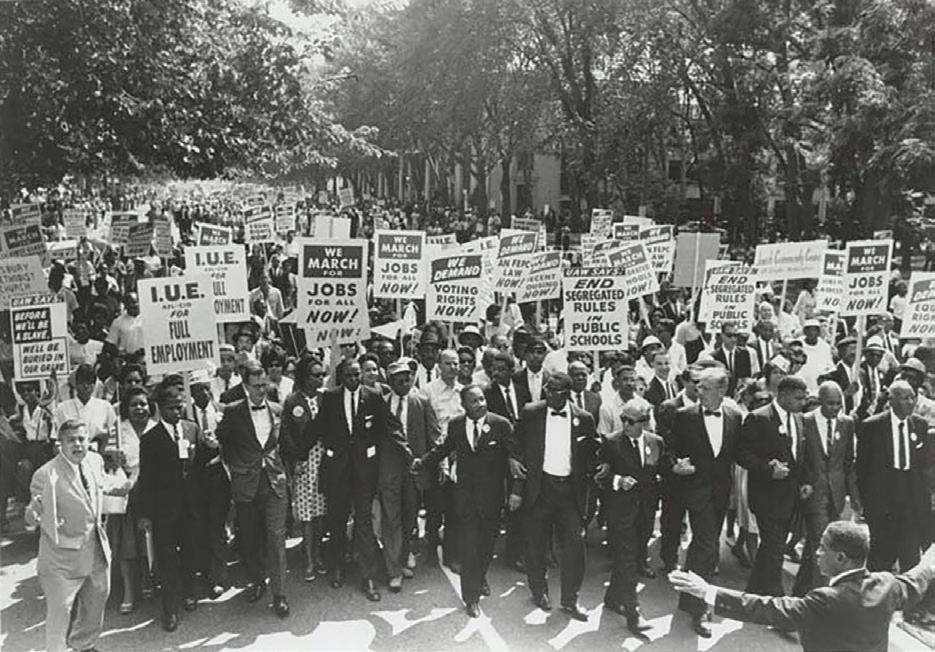
Standing where King stood in front of the Lincoln Memorial 60 years ago, Smith said, “His moral calls for economic justice are what I want to talk to you about today. Because as we stand here, the war on diversity and inclusion threatens all of the progress made through the sacrifices of our ancestors.”
Well-known and applauded for his having paid the student loan balances of the 2019 graduating class of Morehouse College, Smith told the crowd that the war against economic injustice is not nearly over.
“Yes, there are Black millionaires and a few Black billionaires, but our economy is still structured to keep profits and power out of the hands of Black folks,” Smith said, pointing out that the average white family has wealth that is 12 times greater than the average Black family.”
According to data from Synchrony Bank, the medium net worth of a Black family is $24,100 verses $188,200 for a White family.
Smith concluded, “As we honor the legacy of Dr. King, we must expand our focus to include economic justice.” He called on Americans of all colors to invest in the Black community. Smith’s speech preceded Martin Luther King III, who asked the thousands, “What are we going to do?” King concluded, “We need all of us to be engaged.”
Like Smith and King, the Rev. Al Sharpton concluded
the rally portion of the day before the march by calling for racial unity behind the cause of economic justice. Reflecting on attacks on affirmative action and against businesses and corporations with racial diversity programs, Sharpton announced that he would lead “a fall of economic sanctions against those who bow to this.”
Sharpton concluded, “If you think you can take money out of our homes and communities, we are not going to allow that to happen.”
While the Great Migration saw approximately six million Black Americans move out of the South into the urban metropolises of the North, Midwest, and West in search of a better life, the economic opportunities many of them hoped for did not materialize.
King knew this all too well, using a 1966 essay for the Nation to paint a portrait of the sprawling urban slums from The Bronx, New York, NY, to the Watts in Los Angeles, CA, and argued that the attainment of political rights does not end the battle for civil rights.
“The future is more complex,” wrote King. “Slums with hundreds of thousands of living units are not eradicated as easily as lunch counters or buses are integrated. Jobs are harder to create than voting rolls.”
Dr. King’s call for economic justice on the eve of his assassination – when he too called for economic sanctions against opponents of equality – remains unfulfilled. But, decades later in sweltering heat on the National Mall, King’s last vision was echoed by a growing chorus of leaders.
“We must defeat poverty,” said National Urban League President Marc Morial before Sharpton lead thousands in a march to the King Memorial. “We call for a national living wage, for the passage of the child tax credit, for an end to gentrification, to redlining, and we will continue to work and fight until hell freezes over. Then we will fight on the
Damon Hewitt, president and executive director of the Lawyers’ Committee for Civil Rights Under Law, called out what he saw as a double standard, with the end of affirmative action but the continuation of so-called legacy admissions, the practice of favoring applicants with family ties to alumni.
“We fought for it because we know that it’s not a handout,” Hewitt said of steps to boost minority enrollment. “It’s what we deserve.”
Several leaders also cited efforts at the state level since the 2020 election to make voting more difficult, steps in mostly Republican-led states that have had a disproportionate impact on communities of color and drawn numerous lawsuits.
LaTosha Brown, co-founder of the Black Voters Matter Fund, drew on the struggle for civil and voting rights as inspiration to push back harder against restrictive laws and to expand the ability to vote. She noted how Black Americans had once been denied even the ability to learn to read and write.
“And in this country, power is not something that is earned. You’ve got to take power in this country,” she said. “We’re operating in this political context like we’re not fighting for our very lives.”
Virgin Islands Rep. Stacey Plaskett spoke out against attacks made by many Republicans against the country’s core institutions, especially calls to dismantle the Justice Department in the wake of charges brought against former President Donald Trump, including those related to his attempts to remain in power despite losing the 2020 election.
She said the attacks on fundamental pillars of democracy and the suggestion that some people should not be held legally accountable were creating widespread distrust in the federal government and deepening the political divide.
“We can’t have that,” she said.
First Black Woman to Serve in Vermont Legislature to be Honored Posthumously
MONTPELIER, Vt. (AP) –– The first Black woman to serve in the Vermont Legislature is being honored posthumously with an achievement award.
The family of former Rep. Louvenia Dorsey Bright, who served in the Vermont House from 19881994 and died in July at age 81, will be presented with the 2023 Gov. Madeleine M. Kunin Achievement Award on Saturday in Essex Junction. Bright, who represented South Burlington, fought for race and gender equity, inclusion, and opportunity. She served as ranking member of the Health and Welfare Committee, where she stewarded passage of Vermont’s first Parental and Family Leave Act. She also served on Government Operations Committee. Bright lived out her remaining years in Illinois, but her family has remained engaged in Vermont and New England.
“It is with heavy but joyous hearts that we accept this award on behalf of my mother,`` her son said in a statement. “We’re honored and humbled that her work is still being celebrated and that her legacy will live on. Her work on race and gender, equity, inclusion, and opportunity is still relevant today and we hope her story will inspire the next generation of leadership in Vermont.”
The award will be presented during the 10th anniversary celebration of Emerge Vermont, an organization that recruits, trains and provides a network to Democratic women who want to run for office.
White House Office of Gun Violence Prevention to Tackle Epidemic Biden-Harris Administration Launches
By Stacy M. BrownNNPA Newswire Senior National Correspondent
Gun violence remains a pressing concern for the United States, with over 500 mass shootings and a reported estimate of 25,000 victims in 2023 alone. In response, the Biden-Harris administration has announced a significant step forward in curbing this crisis. President Biden has introduced the inaugural White House Office of Gun Violence Prevention, dedicated to implementing crucial executive and legislative measures to save lives and heal communities.
The office will be under the stewardship of Vice President Kamala Harris, perhaps the administration’s most vocal advocate against gun violence. Stefanie Feldman, a long-serving policy advisor on gun violence prevention, will take the reins as the Director. Joining her are gun violence prevention advocates Greg Jackson and Rob Wilcox, who assume the roles of Deputy Directors.
“Every time I’ve met with families impacted by gun violence as they mourn their loved ones… they all have the same message for their elected officials: ‘Do something,” Biden asserted. He highlighted the importance of recent legislative strides and executive actions but stressed that they represent the initial required phase.
The White House noted that Feldman, the new director of the inaugural office, brings a wealth of experience. Over more than a decade, Feldman has been a stalwart member of Biden’s team, officials noted. Her journey includes instrumental contributions following the tragic Sandy Hook Elementary School shooting in 2012.
Further, Greg Jackson, appointed Deputy Director, brings his own profound experience as a gun violence survivor. As a Community Justice Action Fund leader, he has tirelessly advocated for gun violence prevention, shedding light on its disproportionate impact on marginalized communities.
In response, the Biden-Harris administration has announced a significant step forward in curbing this crisis. President Biden has introduced the inaugural White House Office of Gun Violence Prevention, dedicated to implementing crucial executive and legislative measures to save lives and heal communities.
Historic Confirmation of Gen. Charles “CQ” Brown Jr.
Overcomes Blockade, Signals Milestone for Representation
By Stacy M. Brown NNPA Newswire Senior National CorrespondentWith a rare display of bipartisan support in the Senate on Wednesday night, Air Force Gen. Charles “CQ”
Brown Jr. overcame a protracted obstruction by Alabama
News Observer The Valley’s
Adjudicated a Newspaper of General Circulation on July 2, 1991, Los Angeles Superior Court Decree, Case No. BS007262, Government Code 6023.
Bulk Mailing Permit 724 Bakersfield, CA 93385
Published every Thursday by The Observer Group Newspapers of Southern California, Inc.
Member: National Newspaper Publishers Assc.
Associated Press, Better Business Bureau, GLAAACC
President: Ellen Coley CEO: Jon Coley
Publisher/ Editor: James Luckey Jr.
Operations Manager: James Luckey
Credo - The Black Press believes that America can best lead the world away from racial and national antagonisms when it accounts to every person, regardless of race, color, or creed full human and legal rights. Hating no person, fearing no person, the Black Press strives to help every person in the firm belief that all are hurt as long as any one is held back.
The Observer Group Newspapers reserves the right to publish views and opinions that may not necessarily reflect those of the staff and management are soleley the product of the responsible individuals who submit commentaries published in these newspapers. Letters, articles and comments appearing in the Observer Newspapers reflect the opinions of the contributor and do not constitute the opinion or endorsement by The Observer Newspapers or its staff. The Observer Group Newspapers assumes no responsibility for photographs, articles, letters, press releases and unsolicited materials. Decisions as to the editiing and publishing of materials are at the discretion of the Publisher and Editors. All rights are reserved on materials accepted for publication unless otherwise specified.
The Observer Group Newspapers of Southern California, Inc.:
Bakersfield News Observer, Los Angeles News Observer, The Valley’s News Observer
The Valley’s News Observer 6060 Center Drive Floor 10, Los Angeles, CA 90045 Mailing Address: PO Box 2341, Bakersfield, Ca. 93303 Phone (661) 324-9466 FAX (661) 324-9472
General Info: observernews@gmail.com
Advertising: observeradvertising@gmail.com
Online: www.ognsc.com
Republican Senator Tommy Tuberville to win confirmation
as only the second Black chairman of the Joint Chiefs of Staff, the highest-ranking military position in the United States.

The resounding vote of 83-11 reflects a strong consensus in favor of Gen. Brown, underscoring the widespread recognition of his qualifications and the importance of diversity in leadership roles within the U.S. armed forces.
Brown’s ascent alongside Defense Secretary Lloyd Austin marked a historic milestone in American military leadership. With this confirmation, the top two positions in the Pentagon are now held by Black men, which the Biden administration said is a testament to the progress made in advancing diversity and inclusion within the U.S. military establishment. The late Gen. Colin Powell was the first Black chairman of the Joint Chiefs of Staff.
This pivotal moment in military history occurs just as the current chairman of the Joint Chiefs, Gen. Mark Milley, prepares to retire, signaling a seamless leadership transition at a critical juncture.
Because of Tuberville’s obtuse blockade, the confirmation process proved challenging. Senate Majority Leader Chuck Schumer orchestrated the votes to circumvent
Tuberville’s months-long blockade on military promotions. This maneuver helped fast-track confirmations for Brown and numerous other nominees, including Randy George and Eric Smith, whose confirmations are anticipated in the days ahead.
Yet, Tuberville’s hold remains firmly in place for nearly 300 military nominees, leaving these candidates and their families uncertain and leaving the nation in a precarious military position globally. The blockade is rooted in Tuberville’s objection to a Pentagon policy that provides reimbursement for out-of-state travel for service members seeking access to abortion services. This stance has drawn sharp criticism. Pentagon officials, along with members of the Biden administration and congressional Democrats, argue that this prolonged state of limbo poses a significant national security risk. “This is not a sustainable path. Sen. Tuberville’s continued abuse of his privilege will continue to disrupt the lives of hundreds of our nation’s finest and most dedicated military officers and their families,” Schumer asserted. “And while Democrats didn’t choose this fight, we are ready to put an end to this sooner rather than later.”
Additionally, Rob Wilcox, also assuming the role of Deputy Director, has a distinguished background in advocating for gun safety measures. Wilcox’s artwork is a tribute to his cousin Laura, a victim of gun violence, and it draws inspiration from personal loss.
The White House said the establishment of the Office of Gun Violence Prevention builds on the historic actions already taken by Biden. This includes signing the Bipartisan Safer Communities Act, a landmark piece of legislation aimed at preventing gun violence.
Officials insisted that efforts to implement the Bipartisan Safer Communities Act have yielded tangible results. They pointed out that the legislation has increased the Justice Department’s ability to prosecute firearms traffickers, restricted access to firearms for those under 21, and increased mental health support for victims of gun violence.

The Biden-Harris Administration also noted they’ve introduced many executive actions to address the root causes of gun violence, including measures to curb the proliferation of dangerous weapons, hold rogue gun dealers accountable, and provide law enforcement with essential resources.
Biden has advocated for a ban on assault weapons and high-capacity magazines, mandated safe storage of firearms, universal background checks, and an end to gun manufacturers’ immunity from liability. His Safer America Plan also proposes increased investment in community policing and gun violence prevention.
“This epidemic of gun violence requires urgent leadership to end the fear and trauma that Americans experience every day,” Harris affirmed. The vice president affirmed the administration’s unwavering commitment to a safer nation, pledging that “no effort would be spared in achieving this goal.”
With this confirmation, the top two positions in the Pentagon are now held by Black men, which the Biden administration said is a testament to the progress made in advancing diversity and inclusion within the U.S. military establishment.
Book Censorship on the Rise in U.S. Libraries
Reports a 20% Increase in Challenges in 2023
By Stacy M. Brown NNPA Newswire Senior National CorrespondentThe assault on Black history and that of other minority groups in the U.S. have ramped up with the recent banning of books. The American Library Association’s Office for Intellectual Freedom (OIF) has released alarming preliminary data indicating a significant surge in attempts to censor books, materials, and services across public, school, and academic libraries in the United States during the first eight months of 2023.
The American Library Association (ALA) compiled crucial data on book challenges from reports filed by library professionals and news stories published nationwide. This year, between January 1 and August 31, 2023, OIF documented a staggering 20% increase in challenges, with 695 attempts to censor library materials and services. The challenges encompassed 1,915 unique titles, marking an escalation from the same period in 2022.
Books written by or about people of color or members of the LGBTQIA+ community are primary targets. Challenges within public libraries accounted for nearly half of documented cases, a sharp rise from 16% last year.
Rise in Multiple Title Challenges
What sets 2023 apart from previous years is the continued surge in simultaneous challenges to multiple titles. A staggering 92% of books challenged were part of attempts to censor multiple titles, compared to 90% in the first eight months of 2022. Cases involving challenges to 100 or more books were reported in 11 states, a significant increase from just six states during the same reporting period in 2022 and none in 2021. Previously, most challenges aimed to remove or restrict a single book. However, this year, a single challenge targeting multiple titles has become the predominant contributor to the rise in censorship attempts. “These attacks on our freedom to read should trouble every person who values liberty and our constitutional rights,” said OIF Director Deborah Caldwell-Stone. “To
allow a group of people or any individual, no matter how powerful or loud, to become the decision-maker about what books we can read or whether libraries exist is to place all of our rights and liberties in jeopardy.”
She further emphasized the expanding focus of groups with political agendas. “Expanding beyond their wellorganized attempts to sanitize school libraries, groups with a political agenda have turned their crusade to public libraries, the very embodiment of the First Amendment in our society,” Caldwell-Stone insisted. “This places politics over the well-being and education of young people and everyone’s right to access and use the public library.”
Public Cases of Censorship
To ALA documented several public cases of censorship:
• Samuels Public Library (Front Royal, Va.): A local pressure group called “Clean Up Samuels” organized bookbanning BBQ events, intending to fill out Request for Reconsideration forms for library materials. Their efforts primarily targeted LGBTQIA+ materials, resulting in over 500 forms completed for nearly 150 unique titles. County board members, influenced by the group, voted to withhold 75 percent of the library’s budget until it took action to restrict access to certain books.
• Clinton (Tenn.) Public Library: In response to challenges to books related to gender identity and sexual orientation, the library board voted against creating a special section for such materials. Challenges persisted, with group members advocating for the censorship of LGBTQIA+ representation in library materials. They also called for the library director’s resignation and threatened community members who defended access to resources.
In August, elected officials asked the sheriff to investigate whether 17 books violated Tennessee’s criminal obscenity laws.
• Urbandale (Iowa) Community School District: Officials flagged 374 books for removal from school libraries in response to a state law defining age-appropriate content. The list included titles addressing sex, sex
education, sexual orientation, and gender identity. The list was revised to 65 books, with titles like “The Kite Runner” and “The Handmaid’s Tale” removed.
Call to Action and Banned Books Week

“The antidote to the contagion of censorship is public, vocal support for libraries,” said ALA President Emily Drabinski, who encouraged public support for libraries and for individuals to attend local school or library board meetings, participate in Banned Books Week initiatives, and join the Unite Against Book Bans campaign to combat censorship.
Banned Books Week 2023, scheduled for October 1–7, draws attention to attempts to remove books and materials from libraries, schools, and bookstores. Officials said the theme, “Let Freedom Read,” highlights the urgent need to defend the right to read and support the community of readers, library staff, educators, authors, publishers, and booksellers.
Hollywood Labor Dispute Nears End as Writers Guild Reaches Tentative Deal
By Stacy M. Brown NNPA Newswire Senior National CorrespondentHollywood’s protracted labor conflict has taken a significant step towards resolution. The Writers Guild of America, representing over 11,000 screenwriters, said the 146-day strike might end with the announcement of a tentative agreement on Sunday, Sept. 24.

The forthcoming days will see guild members vote on whether to accept the deal, which aligns with their demands. The demands include higher pay for streaming content, agreements from studios on minimum staffing for TV shows, and protections against AI technology affecting writers’ credits and pay.
According to the New York Times, the Writers Guild’s negotiating committee emailed members, expressing their pride in the deal. They emphasized the meaningful gains and protections for all members.
The Alliance of Motion Picture and Television Producers, representing studios, consistently refrained from celebrating prematurely, offering a concise statement: “The W.G.A. and A.M.P.T.P. have reached a tentative agreement.”
Many in the entertainment industry, profoundly impacted by the streaming revolution catalyzed by the pandemic, view this tentative accord as a crucial stride toward stabilization. However, a substantial portion of Hollywood remains at a standstill, with tens of thousands of actors continuing their strike and no talks scheduled between the actors’ union, SAG-AFTRA, and the studios.
Only productions devoid of actors, such as latenight shows hosted by Jimmy Fallon and Stephen Colbert and daytime talk shows hosted by Drew Barrymore and Jennifer Hudson, stand poised for a swift restart.
In addition to actors, over 100,000 behind-the-scenes professionals in Los Angeles and New York face continued idleness, grappling with escalating financial strain. According to Governor Gavin Newsom, the Hollywood shutdown has cost California’s economy more than $5 billion.
SAG-AFTRA has been on strike since July 14, with demands surpassing the Writers Guild’s. The studio alliance prioritized talks with the Writers Guild because of SAG-AFTRA’s leader, Fran Drescher, who pushed for 2% of streaming show revenue. Studios considered this point non-negotiable.
However, given shared concerns, the agreement with the Writers Guild could expedite negotiations with the actors’ union. Actors, like writers, harbor apprehensions over the potential use of A.I. to create digital likenesses or alter performances without consent or compensation.
Reportedly, artificial intelligence became the crucial factor during the last stage of negotiations. Entertainment company lawyers finalized language that addressed the guild’s concerns about artificial intelligence and ownership of old scripts. Senior company leaders, including Robert
A. Iger, Donna Langley, Ted Sarandos, and David Zaslav, directly joined the talks. Hollywood workers have tapped into over $45 million in hardship withdrawals from the Motion Picture Industry Pension Plan as the strike persists. Warner Bros. Discovery
anticipates a $300 million to $500 million reduction in adjusted earnings for the year due to the dual strikes. The agreement gives hope to Hollywood’s recovery, which could prevent billions in losses and financial hardships for workers.
Usher Set to Headline 2024 Super Bowl Halftime Show
By Stacy M. Brown NNPA Newswire Senior National CorrespondentGrammy-winning artist Usher plans to dazzle hundreds of millions of fans as he takes center stage for the highly anticipated 2024 Super Bowl halftime show. On February 11, 2024, the renowned performance will occur at the Allegiant Stadium in Paradise, Nevada, just outside the famed Las Vegas Strip.

Kim Kardashian surprised Usher with a phone call to announce that he would be headlining at X (previously known as Twitter).
The appearance will mark Usher’s second appearance at the Super Bowl, following his 2011 performance alongside the Black Eyed Peas. Rihanna headlined the event last year and revealed her pregnancy to A$AP Rocky during her unforgettable performance.
“It’s an honor of a lifetime to finally check a Super Bowl performance off my bucket list. I can’t wait to bring the world a show unlike anything else they’ve seen from me before,” Usher said in a statement.
He extended his gratitude, saying, “Thank you to the fans and everyone who made this opportunity happen. I’ll see you real soon.”
Jay-Z, whose Roc Nation company is returning to produce the halftime show for the fifth consecutive year, also commended Usher. “Usher is the ultimate artist and showman. Ever since his debut at 15, he’s been charting his own unique course. Beyond his flawless singing and exceptional choreography, Usher bares his soul,” Jay-Z stated.
He added, “His remarkable journey has propelled him to one of the grandest stages in the world. I can’t wait to see the magic.” The rapper, 53, and Usher, 44, have previously collaborated on tracks including “Hot Tottie,” “Anything,” and “Best Thing.”
Super Bowl LVIII will be broadcast live on CBS on February 11, 2024. The iconic halftime show generally draws hundreds of millions of viewers, making it one of the most sought-after platforms in music.
more in a civil case. The court’s lien must be paid before the court will dismiss the case. ¡AVISO! Lo han demandado. Si
no responde dentro de 30 días, la corte puede decidir en su contra sin escuchar su versión. Lea la información a continuación. Tiene 30 DÍAS DE CALENDARIO después de que le entreguen esta citación y papeles legales para presentar una respuesta por escrito en esta corte y hacer que se entregue una copia al demandante. Una carta o una llamada telefónica no lo protegen. Su respuesta por escrito tiene que estar en formato legal correcto si desea que procesen su caso en la corte. Es posible que haya un formulario que usted pueda usar para su respuesta. Puede encontrar estos formularios de la corte y más información en el Centro de Ayuda de las Cortes de California (www. sucorte.ca.gov), en la biblioteca de leyes de su condado o en la corte que le quede más cerca. Si no puede pagar la cuota de presentación, pida al secretario de la corte que le dé un formulario de exención de pago de cuotas. Si no presenta su respuesta a tiempo, puede perder el caso por incumplimiento y la corte le podrá quitar su sueldo, dinero y bienes sin más advertencia. Hay otros requisitos legales. Es recomendable que llame a un abogado inmediatamente. Si no conoce a un abogado, puede llamar a un servicio de remisión a abogados. Si no puede pagar a un abogado, es posible que cumpla con los requisitos para obtener servicios legales gratuitos de un programa de servicios legales sin fines de lucro. Puede encontrar estos grupos sin fines de lucro en el sitio web de California Legal Services, (www. lawhelpcalifornia.org), en el Centro de Ayuda de las Cortes de California, www.sucorte.ca.gov) o poniéndose en contacto con la corte o el colegio de abogados locales. AVISO: Por ley, la corte tiene derecho a reclamar las cuotas y los costos exentos por imponer un gravamen sobre cualquier recuperación de $10,000 ó más de valor recibida mediante un acuerdo o una concesión de arbitraje en un caso de derecho civil.

Minority Environmental Justice Orgs Want to Connect to Millions in EPA Funding for California
By Lila Brown California Black MediaEnvironmental justice advocates in California petitioned Gov. Gavin Newsom this past summer, asking the state to direct a portion of the millions in federal and state dollars California is investing in cleaning and greening communities to Black and other minority organizations.
The California Environmental Justice Alliance (CEJA) say the programs they have in place to restore decades of environmental devastation and neglect in minority communities can play a key role in achieving the state and federal green goals to enforce regulations and distribute resources more fairly and equitably.
“There’s systemic racism that we are trying to dismantle that is beyond the usual American concepts of environmentalism and there’s a lot of interrelated and intersecting issues that we’re trying to fix on the ground, Mari Rose Taruc, CEJA’s energy Director, told California Black Media.

Taruc says environmental groups recognizing the harm done to communities of color in the past – and their implication on the local level -- is a critical part of the environmental justice movement.
“Environmental justice was born out of the, the Civil Rights Movement and that is to the credit of, of Black organizers that came out of the South to raise consciousness of environmental pollution and destruction of dumping grounds primarily located in BIPOC communities,” she said.
CEJA is a coalition of the 10 biggest environmental justice organizations that coordinate efforts to protect the health and wellbeing of Black, Indigenous, Latino, and Asian Pacific Islander communities in California. The organization also develops programs and raises money to tackle some of the new challenges communities are facing due to the climate crisis.
In July, Environmental Protection Agency (EPA) Regional Administrator Martha Guzman presented $2 million to Los Angeles Mayor Karen Bass to revitalize the Taylor Yard along the Los Angeles River, turning a former freight railyard into urban green space. The project reinforces President Biden’s goal for Environmental Justice to restore the damage that has been done from previous administrations ranging from decades of neglect to the lack of enforcement as it pertains to environmental laws, regulations, and policies.
Historically, railyards contaminated nearby ground and waters with petroleum and other dangerous contaminants.
Guzman spoke with California Black Media about
policies that led to disadvantaged and low-income communities being the areas where toxic and hazardous wastes were disposed, as opposed to more affluent neighborhoods.
“This can be traced to many of our origins, be it slavery or the taking of indigenous lands here in the West,” she said. “We see where all these facilities are, and we know that race is the largest determinant of pollution.”
Guzman says the Biden administration is keeping equity and environmental justice front of mind.
“We have to invest in these communities because we have to be intentional about dealing with those generations of neglect and land use decisions that led to a disparate impact to our communities,” says Guzman who leads the
EPA efforts to protect public health and the environment for the Pacific Southwest region spanning Arizona, California, Hawaii, Nevada, the U.S. Pacific Islands territories, and 148 Tribal Nations.
The investment strategy, she says, intends to heal legacy issues and now the EPA’s number one priority is enforcement.
According to Bass’ office, the City of Los Angeles plans to restore this site as part of a greater LA River initiative to restore ecosystems and habitats, form walkable trails along 52 miles of the river, and create easy access points for residents to enjoy what the river has to offer.
Throughout California, EPA awarded $9,299,566 in total funding from the Fiscal Year 2023 Brownfields
Multipurpose, Assessment, Revolving Loan Fund, and Cleanup (MARC) Grant Funding through 12 separate grants. According to the EPA, a brownfield is a property, the expansion, redevelopment, or reuse of which may be complicated by the presence or potential presence of a hazardous substance, pollutant, or contaminant. It is estimated that there are more than 450,000 brownfields in the U.S.
“This funding provides unprecedented resources and highlights how President Biden’s Investing in America agenda and the Bipartisan Infrastructure Law are delivering environmental and economic benefits for California,” according to a press release from Guzman’s office.
The EPA is investing nearly $100 billion nationwide to deliver clean water and clean air, advance our transition to clean transportation, and enact environmental justice (EJ), especially in communities that have been disadvantaged and underserved, many of which are lowincome communities or communities of color. In addition, President Biden’s Executive Order 14008 – Tackling the Climate Crisis at Home and Abroad announced Justice40, which mandates that at least 40% of the benefits of specific federal programs-- including Brownfields and those created by BIL and IRA -- must flow to disadvantaged communities. In April 2022, EPA committed to meeting and exceeding this mandate.
Taruc says CEJA has not received any of the EPA funds, but the organization continues to find opportunities for different organizations throughout the state to be able to connect to funding programs focused on environmental justice. One of the ways that CEJA ensures communities are recipients of funds is through programs such as “Solar for All” so that low-income households receive solar panels to improve their homes and lower their fossil fuel consumption, which reduces emissions.
Taruc says one focus of CEJA is ensuring people – particularly disadvantaged minorities who have been disproportionately impacted -- live in safe and clean environments.
“Most environmental justice groups believe we should not build housing next to oil drilling sites and there should be a buffer zone of where you build new housing. We’ve been fighting to close these oil wells because housing should be built in places that are not only affordable but safe,” Taruc concluded.
States Must Ban Guns at Places Where People Vote
Sunita Sohrabji, EMS
Special to California Black Media Partners
Voting and elections have become the targets of threats and intimidation as the nation faces a proliferation of guns, more frequent gun violence, and fewer legal protections, noted Brennan Center for Justice and the Giffords Law Center to Prevent Gun Violence in a report released this week.
The proliferation of guns in American homes has increased dramatically since 2008, when the Supreme Court ruled for the first time that the 2nd Amendment allows US residents to possess an operable handgun in the home for self-defense.
“This was a considerable change from what the court had long held, which was that possessing a firearm had to be related to militia service,” Robyn Sanders, Counsel for the Voting Rights and Election Reform Democracy Project at the Brennan Center, told Ethnic Media Services.
The Supreme Court did caution that the rights secured by the Second Amendment are not unlimited; it identified laws that would forbid firearms in sensitive places, such as schools and government buildings. “And so there, while the Supreme Court handed down what was a dramatic decision at that time, it did specify that regulations are still permissible in places that are sensitive,” said Sanders, who co-authored the report.
But the Supreme Court further weakened gun restrictions last year in its ruling on the New York State Rifle & Pistol Association, Inc. vs. Bruen case. The opinion, written by Justice Clarence Thomas, stated that the American public has the right to carry guns in public for self-defense, and that states cannot require applicants to demonstrate a need for owning a gun.
“The decision in Bruen has invited more legal challenges to gun regulations. But the court also explicitly states that sensitive places are places where states can regulate where
guns can be carried, and they were unequivocal about polling locations being one of those,” said Sanders.
In a Sept. 20 interview with EMS, Sanders discussed the threat gun violence poses for US elections. “We believe this report served a significant purpose in alerting states that there are ways that they could help to maintain the confidence that voters historically had in our elections as being safe and secure from violence and intimidation,” she said.
Excerpts of Conversation with Sanders:
What types of justifications are states using to allow concealed guns at polling sites and drop-off boxes?
The Supreme Court was unequivocal in its decision in Bruen that prohibiting firearms in polling places is constitutional. And so, while I can’t speak for why states have not filled the voids that we recognize in our report, what I can say is that we are offering policy proposals for states to enact laws that would better protect voters and election officials and workers from threats and help voters and the public remain confident that our elections will continue to be by and large peaceful.
Older adults traditionally account for the majority of election workers. Have you seen a drop-off of older adults choosing to work at the polls, given the uncertainty of protection from violence at those sites?

We were experiencing a global pandemic in 2020. And so there was a downturn in retired or elderly folks serving as election workers due to the vulnerabilities related with COVID -19. But it is true that election officials have reported that it’s been harder to recruit the more elderly folks to serve in that capacity.
Compared to anything prior, there was dramatically more harassment and threats lodged at election officials and poll workers over the last two election cycles. Poll workers have reported experiences of harassment and threats of abuse in recent years.
Are election workers of color more likely to face harassment, violence and intimidation?
We found that election officials serving what’s known as majority minority jurisdictions were more likely than election officials overall to report having been threatened, having been harassed or abused because of their job. And they were also considerably more likely to be concerned about being assaulted.
This is alarming, it’s concerning, and it’s unacceptable in a democracy.
One out of every 3 election workers have reported harassment or threats, according to the report.
As a result of the shifts in how our electoral process was being carried out, we started to observe trends in elected leaders and others who were spreading disinformation and misinformation about our elections as it relates to various methods of voting, including voting by mail and the use of drop boxes as a result of the uptick in mail voting.
And so based on that climate, we started to see an increase in threats and intimidation and threats of violence being lodged at election workers and officials. And that was also tied to the election denial movement that took hold at the time as well, where various elected leaders were sowing disinformation and misinformation about our elections and raising conspiracy theories about various methods of voting and really increasing the fear among the electorate that the voting process was insecure and was not fair. So, we think that’s what inspired this increase in the climate of threats and intimidation against election officials.
Could you talk about some of your policy recommendations?
One of the key findings in our report is that only 12 states and Washington, D.C. have laws prohibiting open carry and concealed carry at polling places. And even fewer states have laws that prohibit guns where other sensitive election activity occurs drop boxes as well as places like
Wells Fargo Awards Grant to Brotherhood Crusade
Advances Middle-Wage Workforce Development
LOS ANGELES, CA - (September 25, 2023) –
Brotherhood Crusade is thrilled to announce the support of Wells Fargo through a grant aimed at empowering its Middle-Wage Workforce Development and Career Place initiative. This strategic partnership reflects both organizations’ commitment to fostering economic growth, employment opportunities, and skill development within the community.
Brotherhood Crusade’s Middle-Wage Workforce Development and Career Place program equips youth with the tools and resources necessary to develop skills and thrive in today’s competitive job market. Through comprehensive training, mentorship, and job placement services, the program aims to bridge the gap between job seekers and middle-wage employment opportunities, ultimately contributing to the socioeconomic advancement
of participants. Charisse Bremond-Weaver, President and CEO of Brotherhood Crusade, expressed her gratitude for the partnership, “At Brotherhood Crusade, we believe in creating pathways to prosperity for our community members. With Wells Fargo’s generous grant, we will continue to expand our efforts to empower our youth with the skills and knowledge needed to secure stable, middle-wage jobs. This collaboration exhibits our shared dedication to uplifting lives and building a stronger, more resilient community.”
Wells Fargo’s Vice President and Community Relations Senior Specialist, Jack Olree, commented on the collaboration, “Investing in workforce development is an investment in the future of our community. We are proud to support Brotherhood Crusade and the Middle-

Wage Workforce Development and Career Place initiative, which aligns perfectly with Wells Fargo’s commitment to promoting economic stability and prosperity. By providing individuals with access to essential training and resources, we collectively pave the way for brighter, more secure futures.”
The grant from Wells Fargo will enable Brotherhood Crusade to expand its reach and impact, enhancing the program’s effectiveness in preparing individuals for successful careers in middle-wage occupations. The collaboration between Brotherhood Crusade and Wells Fargo underscores the importance of partnerships that drive positive change and elevate communities through education, employment, and economic empowerment.
election counting facilities.
And while it is illegal to intimidate voters in all 50 states, neither federal law nor any state law explicitly acknowledges that guns in or around places where people are engaged in voting or conducting election activity can constitute illegal intimidation.
In our report, we offer two main policy proposals. One: we recommend that states enact laws to prohibit guns at and around all sites of voting and vote counting. And we recommend that states strengthen their laws, protecting voters and election workers and officials from intimidation and violence, but explicitly addressing the void that is currently present and addressing the intimidating effect of guns.
I would reiterate to voters that — because our elections have remained by and large peaceful — the proposals that we offer in our report are simply action items that states can take to further strengthen legal protections that are already in place.
California Lawmakers Approve Nation Leading $25 Minimum Wage for Health Workers
By Don Thompson California HealthlineSACRAMENTO — A sweeping agreement between labor and the health industry would gradually raise the minimum wage for hundreds of thousands of health workers in California to a nation-leading $25 an hour while ending a years-long battle over dialysis clinics.
The pact approved by state lawmakers on Thursday, the last day of this year’s legislative session, would phase in the wage increase for hospitals, nursing homes, and other medical and psychiatric services providers. The bill now heads to the governor’s desk. A spokesperson for Democratic Gov. Gavin Newsom, Izzy Gordon, said the governor will evaluate the bill on the merits before his Oct. 14 deadline to act on the legislation.
SB 525 would raise the hourly minimum at large health facilities and dialysis clinics to $23 next year, $24 in 2025, and $25 in 2026. It would boost hourly wages at community clinics to at least $21 in 2024, $22 in 2026, and $25 in 2027. Other health facilities would go to at least $21 an hour in 2024, $23 in 2026, and $25 by 2028.
The agreement “now strikes an important balance between supporting workers and protecting jobs and access to care in some of our most vulnerable communities,”
Carmela Coyle, president and CEO of the California Hospital Association, said in a statement. “The bill creates a pathway to improving wages for our lower-wage health care workers, while also recognizing the needs of our state’s most troubled hospitals.”
The deal is a significant union victory during what has been dubbed a “hot labor summer,” with picket lines formed by Hollywood writers and actors, hotel workers, and Los Angeles city employees. Thousands of nurses could be next. Labor also won a $20 minimum wage for California fast-food workers, a significant boost from the current statewide $15.50 minimum wage.
Union leaders say lower-income health workers such as certified nursing assistants, patient aides, and food service workers — many of them racial minorities — need the additional money to keep up. “Health care in California will be more accessible and equitable because workers and healthcare providers stood together and stood up for patient care,” SEIU California Executive Director Tia Orr said of the health care deal.
The phase-in would be slower at hospitals with a high percentage of patients covered by Medicare or Medicaid, rural independent hospitals, and small county facilities. The minimum hourly wage there would go to $18 next
year, then increase annually by 3.5% until it reaches $25 in 2033. Subsequently, at all sites, the $25 minimum wage would be increased annually to keep up with inflation. However, the bill allows health care facilities to apply for a temporary pause or slower phase-in if they can show state officials that providing the required minimum wage “would raise doubts about the covered health care facility’s ability to continue as a going concern.”
State Sen. María Elena Durazo, the Los Angeles Democrat who introduced the bill, called her bill “a first in the nation historic investment in our healthcare workforce.” The measure “is a critical step to ensuring that we are addressing our healthcare workforce shortage,” she
said before the bill received final passage late Thursday in the Senate.
As part of the deal, in a separate memorandum of understanding, Service Employees International UnionUnited Healthcare Workers West would drop its effort to impose regulations on dialysis clinics through legislation and at the ballot box. Voters defeated all three ballot initiatives, most recently last year, but the fight has cost the dialysis industry hundreds of millions of dollars.
California Dialysis Council spokesperson Jaycob Bytel said in a statement that the agreement “protects patients from the ongoing threats at the ballot and in the legislature.” It bars for four years any legislation or statewide or local ballot measures by either SEIU or the dialysis industry.
The union has pushed for wage boosts in several California cities. But the agreement bars local governments from requiring higher local minimum wages for health care workers for 10 years, until 2034. Local governments could set higher local minimum wages, but they must include all workers.
The original bill cleared the Senate in May with no votes to spare amid strident opposition from employers, who said they couldn’t afford it. The California Chamber of Commerce put the proposal on its annual “job killer” list, a designation that often is enough to kill controversial legislation. The No SB 525 coalition, which included hospitals, doctors, and business and taxpayer groups, had said the bill would cost $8 billion annually, endangering services and leading to higher premiums and higher costs for state and local governments.
Republicans who opposed the bill echoed those arguments while saying the increases will harm rural health facilities. “We’ll see hospitals go out of service and we will see rural health clinics for sure be severely impacted and probably go out of business,” warned state Sen. Brian Dahle, a Republican who represents rural Northern California. The bill’s opponents also included the California Nurses Association, which said it could prompt employers to lower wages for registered nurses. The association helped scuttle a push for a $25 hourly minimum wage for health workers a year ago. That earlier effort failed in part because it was tied to a delay in earthquake-safety upgrades at hospitals.
The University of California-Berkeley Labor Center projected that the increase would boost wages for more than 469,000 health workers. The center estimates it would most benefit workers of color, who make up 70% of those workers, and women, who represent about three-quarters.

The bump would help about 40% of California’s health workers, earning them on average an extra $10,352 a year and reducing their reliance on Medi-Cal, saving between $181 million and $363 million in the second year of the wage increase, according to a legislative analysis. The analysis said opponents’ $8 billion cost estimate is overblown because it fails to include billions in state assistance to hospitals.
KFF Health News is a national newsroom that produces in-depth journalism about health issues and is one of the core operating programs at KFF—an independent source of health policy research, polling, and journalism. Learn more about KFF.
California Black Media Political Playback: News You Might Have Missed
Tanu Henry and Joe W. Bowers Jr. California Black Media
Legislative Black Caucus Chair “Extremely Disappointed” by Gov. Newsom’s Veto of Child Gender
Identity Bill
Assemblymember Lori D. Wilson (D-Suisun City) says she’s extremely disappointed by Gov. Gavin Newsom’s decision to veto Assembly Bill (AB) 957, legislation that would have required judges in custody cases to consider a parents’ affirmation of their child’s gender identity in their application of the law.
Wilson, who is the chair of the California Legislative Black Caucus and who has a transgender child said, “I know the Governor’s record. He has been a champion for LGBTQ+ rights even before it was popular to do so.” “However, on this point, the Governor and I disagree on the best way to protect transgender kids,” Wilson continued. “I’ve been disheartened over the last few years as I’ve watched the growing hate and heard the vitriol towards the trans community. My intent with this bill was to give them a voice, particularly in the family court system, where a non-affirming parent could have a detrimental effect on the mental health and wellbeing of a child. Whether the roadblock comes from the opposition or even a supporter, it only hardens my resolve. I’m far from done, this fight is
personal! Not just for my family, but to all the trans kids that deserve a brighter and safer future.”
The Governor announced his decision in a press release his office sent out Friday that listed bills he has so far signed and others he has vetoed. Oct. 14 is the deadline for Newsom to sign bills lawmakers introduced during the 2023 legislative session. Explaining his decision to veto AB 957 in a message, Newsom said people elected officials could point to the legislation as precedent to “diminish the rights of vulnerable communities.”
“I am returning Assembly Bill 957 without my signature,” Newsom wrote. “I appreciate the passion and values that led the author to introduce this bill. I share a deep commitment to advancing the rights of transgender Californians, an effort that has guided my decisions through many decades in public office.”
That said,” the Governor continued in his message, “I urge caution when the Executive and Legislative branches of state government attempt to dictate - in prescriptive terms that single out one characteristic - legal standards for the Judicial branch to apply.”
State Controller Malia Cohen to Chair State Task Force on Charter School Audits
California State Controller Malia Cohen announced last week that she will chair a “statewide multi-agency task force charged with developing audit criteria and best practices for identifying and preventing fraud in charter schools.
San Diego Superior Court Judge Robert Longstreth formed the task force after the state charged 11 defendants – including a school superintendent -- for defrauding taxpayers of nearly $400 million by enrolling fictitious students in A3 Education, an online charter school, to collect state funds to educate each student.
Cohen says the leading defendants in the case Sean McManus and Jason Schrock have agreed to turn over all the assets of A3 Education and its subsidiaries to the state – and $215 million which will be put back in the “state’s coffers.”
“As the State’s chief fiscal officer and the office responsible for developing audit guidelines to be followed by auditors when auditing school district, I could not in good conscience allow this matter to proceed through the judicial system without offering my office’s assistance in drafting guidelines to detect and prevent a recurrence of this untenable situation,” said Cohen. “To do otherwise would be to neglect the confidence placed in my office to safeguard taxpayers’ dollars.”
S.F. Mayor London Breed: Reparations “Best Handled at Federal Level”

Last week, San Francisco’s Mayor London Breed issued a statement that reparations – particularly cash payments -- for past injustices suffered by Black Americans who are descendants of enslaved people are best handled at the federal level. Breed issued the statement after the San Francisco Board of Supervisors’ endorsement on Sept. 19 of a reparations plan submitted in June by an advisory board of
Black leaders in the city. The 400-page plan lists 115 recommendations, including individual payments of up to $5 million per eligible Black resident. It also calls for investments in Black-owned businesses, education, housing and attracting more Black residents to the city. In her statement, Breed committed to undertake certain city initiatives to address inequity like a guaranteed income program and implementing a plan to allocate $60 million every year for investment in the Black community.
California Insurance Commissioner Ricardo Lara Announces Plan to Strengthen Industry
California has the largest home insurance market in the country, but, this year, large private companies like Allstate and State Farm have been making plans to pull out of it, citing too many regulations and the frequency of natural disasters like wildfires and extreme winter storms in the state. Seven major companies have either decided to no longer sell insurance in California or they have announced plans to place restrictions on where they provide coverage in the state.
Last week, California Insurance Commissioner Ricardo Lara unveiled a state plan, the California’s Sustainable Insurance Strategy, to improve insurance options for Californians while strengthening and modernizing the market as the state continues to face intensifying climate threats.
“We are at a major crossroads on insurance after multiple years of wildfires and storms intensified by the threat of climate change. I am taking immediate action to implement lasting changes that will make Californians safer through a stronger, sustainable insurance market,” said Lara. “The current system is not working for all Californians, and we must change course. I will continue to partner with all those who want to work toward real solutions.”
On Thursday, Gov. Gavin Newsom issued an executive order calling for immediate actions to sustain and stabilize the market and expand insurance options for Californians.
It is critical that California’s insurance market works to protect homes and businesses in every corner of our state,” said Newsom. “A balanced approach that will help maintain fair prices and protections for Californians is essential.
The California Mortgage Bankers Association said homebuyers, who are mandated to buy insurance when they sign up for mortgages, deserve better options.
“The agreement that Commissioner Lara has reached to expand insurance availability across our state means more Californians can be able to achieve the dream of homeownership knowing they will have better access to the insurance they need,” he said.
California’s Congressional Delegation Urges President Biden to Grant Gov. Newsom’s Request for Major Disaster Aid
In a letter dated Sept. 19, California’s delegation to the United States Congress -- including the state’s two Democratic Senators, Dianne Feinstein and Alex Padilla, and Speaker of the U.S. House of Representatives
(L to R) Assemblymember Lori Wilson (D- Suisun City) Gov. Gavin Newsom
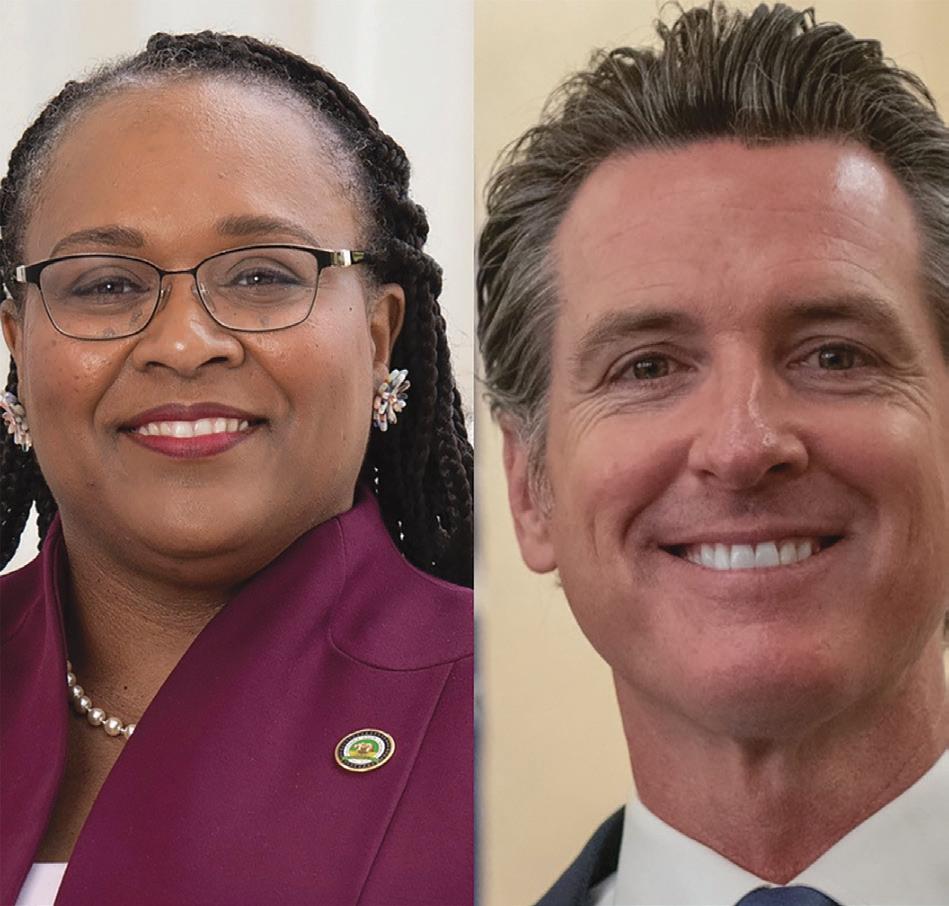
Kevin McCarthy (R-CA-20) – urged President Biden to “expeditiously” approve Gov. Newsom’s request for a major disaster declaration after Tropical Storm Hilary.
“The heavy precipitation caused dangerous debris flows that threatened lives, businesses, and critical public infrastructure such as roads and waterways,” wrote the lawmakers. “In response to these dangerous conditions, the State of California marshaled all available resources to respond to this storm. However, the severity and intensity of this storm require additional federal coordination and resources to effectively support the ongoing recovery efforts.”
According to the lawmakers, residents of the following counties are in dire need of public assistance: Imperial, Inyo, Kern, Los Angeles, Riverside, San Bernardino, San Diego, Siskiyou, and Ventura.
They also asked the feds for emergency and disaster loans that will benefit affected Californians from the U.S. Small Business Administration and the U.S. Department of Agriculture.
Former L.A. County Prosecutor Christopher Darden Announces Run for LA County Superior Court Judge
Last week, Christopher Darden, an attorney, bestselling author, law professor and former L.A. County prosecutor announced his candidacy for L.A County Superior Court judge. The elections will be held next March. Darden, 67, a Richmond native, gained national prominence when he served as a co-prosecutor in the 1994 O.J. Simpson murder trial.
Legislature Passes Newsom’s Proposal to Retool Mental Health Services Act
By Molly Castle Work California HealthlineThe California Legislature passed a pair of bills greenlighting Gov. Gavin Newsom’s campaign to build 10,000 new beds and housing units and increase drug addiction treatment as part of his response to the state’s homelessness and drug crises. The Democratic governor is expected to sign the bills, which received bipartisan support. The first bill, SB 326, is designed to transform the state’s Mental Health Services Act into the Behavioral Health Services Act, using an existing tax on millionaires to treat the most seriously mentally ill and to increase programs for substance use disorders. The second, AB 531, authorizes the state to issue $6.38 billion in bonds to build more housing for homeless people and treatment beds for those with the most severe needs.
Newsom will now ask voters to approve the changes on the March primary ballot.
“This reform will bring much needed accountability currently lacking at the local and state level, increased
transparency and visibility into the whole mental health and addiction treatment system, and a modernized focus to address today’s crises,” Newsom said in a statement. According to a June statewide study on homelessness by the University of California-San Francisco, more than 171,000 Californians experience homelessness daily, representing 30% of the nation’s homeless population. The majority of participants in the study reported high lifetime rates of mental health and substance use challenges; 82% reported a period in their life in which they experienced a serious mental health condition, and nearly two-thirds reported the use of illicit drugs or heavy drinking. The mental health act was passed as Proposition 63 by voters in 2004 and levied a tax of 1% on income above $1 million, known as the “millionaire’s tax.” That money then flowed from the state to counties for use in five mental health areas, including community support, prevention, and facilities. Funding changes year to year, but the tax generated $3.3 billion in the 2022-23 fiscal year, according to the nonpartisan Legislative Analyst’s Office. However, the program has been criticized over the
years for falling short of its initial promise. Last year, the Los Angeles Times highlighted several reasons, including revenue swings, consistent underfunding of social and mental health programs, tension between state and county officials, and a shortage of mental health clinicians.
Newsom pledged that the newly renamed Behavioral Health Services Act would build 10,000 new beds and housing units for people experiencing homelessness who have behavioral health needs. It would also focus on diversifying the workforce and improving accountability — tracking outcomes in a more detailed way — so the government can understand what’s working and what’s not.
However, counties that administer this money at the local level have raised concerns. A letter from the California State Association of Counties and other organizations representing local government interests expressed fear that Newsom’s proposal would result in counties receiving significantly less funding for core services, little protection from fluctuation in funds, and less flexibility in spending.
The governor’s office emphasized that new requirements still provide flexibility.
Assembly member Jacqui Irwin (D-Thousand Oaks), who was the lead author of the bond bill and served for seven years as the chair of the body’s Military and Veterans Affairs Committee, is particularly proud of a provision that will reserve $1.07 billion for housing for veterans. California has the largest number of veterans experiencing homelessness — 31% of the nation’s homeless veteran population — according to a 2021 homelessness report by the U.S. Department of Housing and Urban Development.
“Getting veterans experiencing homelessness off the streets has long been a priority for California, but getting some of our most vulnerable veterans into needed treatment for behavioral health challenges will be transformative,” Irwin said.
Sen. Susan Talamantes Eggman (D-Stockton), who co-authored the bond bill and was the lead author of the other bill, said the bills are critical to the state’s continuum of care. “Together they will build out voluntary housing, reprioritize resources to those with the greatest needs, and provide a true safety net to prevent the many people falling through the cracks that we see today,” she said.
Gov. Newsom’s Education Plans May Be Tone Deaf to Black Parents’ Concerns
By Joe W. Bowers Jr.California Black Media
Recently, Gov. Gavin Newsom conducted press briefings at Sacramento area public schools to talk about the initiatives he’s supporting to reform and revolutionize public education in California.
At the Miwok Village Elementary School in the Elk Grove Unified School District, Newsom promoted his “California’s Family Agenda,” a public-school initiative that aims to provide students with the right environment and opportunities for growth, learning, and success.
At River City High School in the Washington Unified School District, Newsom signed an executive order that initiates the development of a Master Plan on Career Education to prepare students for future careers, including those that don’t require college degrees.
Newsom has made K-12 education a top priority. Among his accomplishments are increased funding to reduce class size, the hiring of more teachers, providing more resources for students; and universal transitional kindergarten. The Governor has also expanded afterschool and summer programs, especially support for student tutoring; universal free school meals; full-service community schools; and ethnic studies in high school.
While Newsom has tried to improve equity and outcomes for all students, a comprehensive survey titled “California Black Voters Perspectives on the Quality of Education for Black Students” commissioned by the Black in School Coalition (BISC) found that only 27% of Black voters agree that Newsom is doing enough to improve educational outcomes for Black students.
The BISC is a statewide organization dedicated to enhancing academic and social outcomes for Black students in California. Their statewide survey of 1,200 Black voters gauges Black voter viewpoints on education funding, school performance, and major challenges confronting Black students. Insight from the survey provides valuable information for policymakers, educators,

and other stakeholders to develop more effective programs to enhance the educational experience of Black students.
Newsom’s Family Agenda is centered around four freedoms: Freedom to Decide, Freedom to Thrive, Freedom to Learn, and Freedom to Succeed. It includes initiatives to invest in community schools and high schools with specialized career and trade pathways. It provides parents and students with access to high-quality instruction, wraparound services, and social assistance.
“We believe in parents’ rights to decide and support their kids. We believe that kids have the right to learn and the right to succeed. And that’s what our agenda lays out,” Newsom said.
Newsom’s Master Plan on Career Education aims to
strengthen career pathways, prioritize practical learning, and promote universal access and affordability through collaboration across government and the private sector.
“California is leveraging billions of dollars in investments to prepare students and workers for goodpaying, long-lasting, and fulfilling careers,” Newsom announced.
Attending the press conference in support of the Career Education Master Plan were State Superintendent of Public Instruction Tony Thurmond, University of California President Michael Drake, Cal State Chancellor Mildred Garcia, CA Community College Chancellor Sonya Christian, and other state officials and legislators.
But Newsom failed to highlight in the press conferences how his education initiatives will tackle concerns Black voters have regarding the quality of education Black students are receiving.
Black students remain the lowest performing academic subgroup in California public schools despite Newsom’s efforts. Seventy percent of Black students are not meeting English language arts standards, and 84% are not meeting math standards. Black students are disproportionately suspended and expelled from school. In the 2021-22 academic year, Black students, who made up 10.7% of the student population, accounted for 23.3% of suspensions and 19.1% of expulsions. The disparity is most pronounced in early childhood education, where Black male students are 6.2 times more likely to be suspended than their peers of other races.
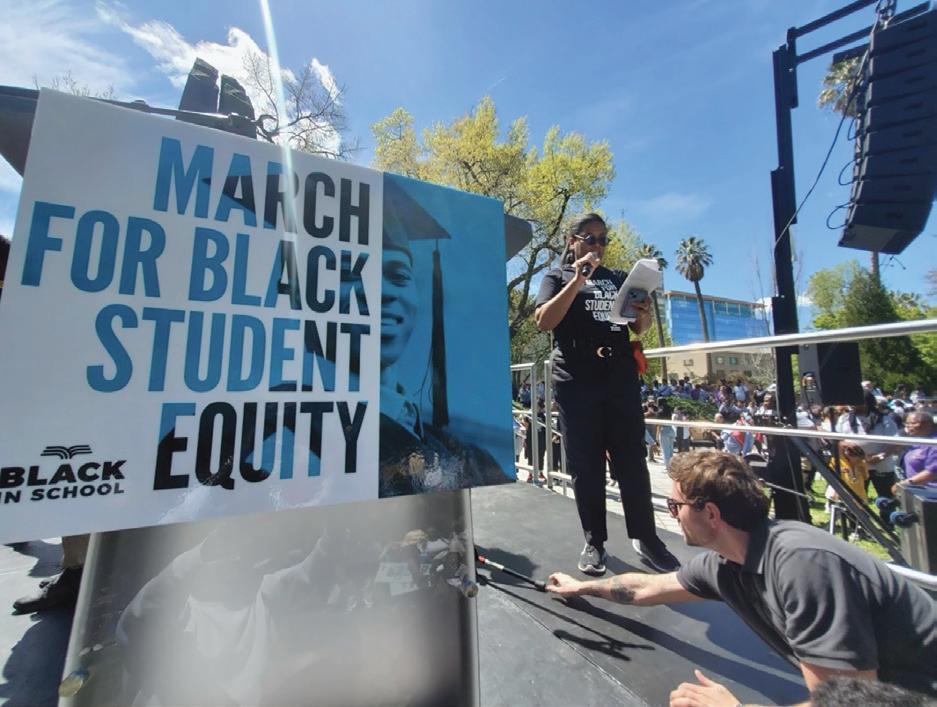
Despite the ongoing challenges, there have been encouraging advancements for Black students under Newsom’s leadership. This year’s budget includes an ongoing funding of $300 Million called the Equity Multiplier to fulfill a commitment he made to Assemblymember Akilah Weber (D-La Mesa) who introduced a bill which would have provided more money for Black K-12 students.
Margaret Fortune, the President and CEO of the Fortune School of Education and a leader of BISC, has
expressed concerns about Newsom’s plan for distributing Equity Multiplier funds. She argues it deviates from Weber’s bill intent by directing the funding towards high-poverty schools instead of specifically towards Black students. The funding protocol appears to undermine the bill’s intent, with BISC analyses showing that only 11% of the funds are benefiting Black students.
Seventy-nine percent of respondents in the BISC survey supports a legislative proposal to change the public-school funding formula by creating a new grant for California’s lowest performing subgroups, including Black students.
Fortune told California Black Media (CBM) that she will be pushing in for the Equity Multiplier in future state budgets to be based on academic achievement, not on income. “It is a permanent part of our funding mechanism in California, there’s an opportunity to have that conversation,” Fortune said. Newsom’s office told CBM that it would not comment on the BISC poll because it has not obtained access to its underlying methodology and a breakdown of its results. They stated, “The Governor’s sweeping initiatives to improve equity in education and ensure Black children and families succeed have received strong praise and wide recognition from Black leaders across the state – including the California Legislative Black Caucus and academic leaders including the California Association of African American Superintendents and Administrators.”
In the BISC survey, 48% of respondents do not believe that the California Legislature is working hard to improve education for Black students.
While Newsom and the Legislature, especially the California Legislative Black Caucus, have supported initiatives aimed at improving educational outcomes for Black students, Black voters and Black education advocates believe they are not specific enough and fail to consider the unique needs of Black students.
Californians Headed to HBCUs in the South Prepare for College Under Abortion Bans
By April Dembosky, KQED California HealthlineWhen I’laysia Vital got accepted to Texas Southern University, a historically Black university in Houston, she immediately began daydreaming about the sense of freedom that would come with living on her own, and the sense of belonging she would feel studying in a thriving Black community.
Then, a nurse at her high school’s health clinic in Oakland, California, explained the legal landscape of her new four-year home in Texas — where abortion is now fully banned.
Vital watched TikTok videos of protesters harassing women outside clinics in other states. She realized her newfound freedoms would come at the expense of another. That’s when she added one more task to her off-to-college checklist: get a long-acting, reliable form of birth control before leaving California.
“I don’t want to go out there and not know anything, not know where to go, because I’m in a new state. So I’m trying to be as prepared as I can before I leave,” she said.
The change is a huge culture shock for Vital and some of her classmates, who for the past four years at Oakland Technical High School have had access to their own health clinic on campus.

This summer, nurses at the Oakland clinic have formalized the “senior send-off” appointment, during which they counsel students about their legal rights and medical options before they leave for college.
After Roe v. Wade was overturned last year, clinic staffers realized students of color could be disproportionately affected by changes in state abortion laws. Many of them, like Vital, were choosing to go to historically Black colleges and universities in Southern states, where bans and limits on the procedure are more common.
“Many students here are just totally floored when I tell them that these laws are different in the states that they’re going to,” said Arin Kramer, a family nurse practitioner at the TechniClinic. Like many adults, “they can’t believe that they can’t get an abortion in this country.”
Kramer has been writing prescriptions for a year’s supply of contraceptive pills or patches, which students can pick up all at once.
Under California law, students can get contraception for free, without having to tell their parents or use a parent’s insurance plan. Students can pick up the prescription at the school clinic, or Kramer can call it in to a pharmacy near the student’s home.
During her own “senior send-off” appointment, Vital told nurse Kramer she was in the market for something even more reliable than pills.
“Because I’m very forgetful. Even if I set an alarm or write it down, it will still slip my mind,” Vital said.
She wanted a long-term contraceptive, like an IUD or a hormonal implant that would last for years and require no upkeep.
The American College of Obstetricians and Gynecologists and the American Academy of Pediatrics have made these options their top recommendation for adolescents after research from both groups showed they were safe and highly effective at preventing teen pregnancy.
So at Oakland Tech and other school-based health clinics run by nonprofit La Clínica de La Raza, Kramer has trained other nurse practitioners how to insert these devices — so students can get them the same day they ask for them.
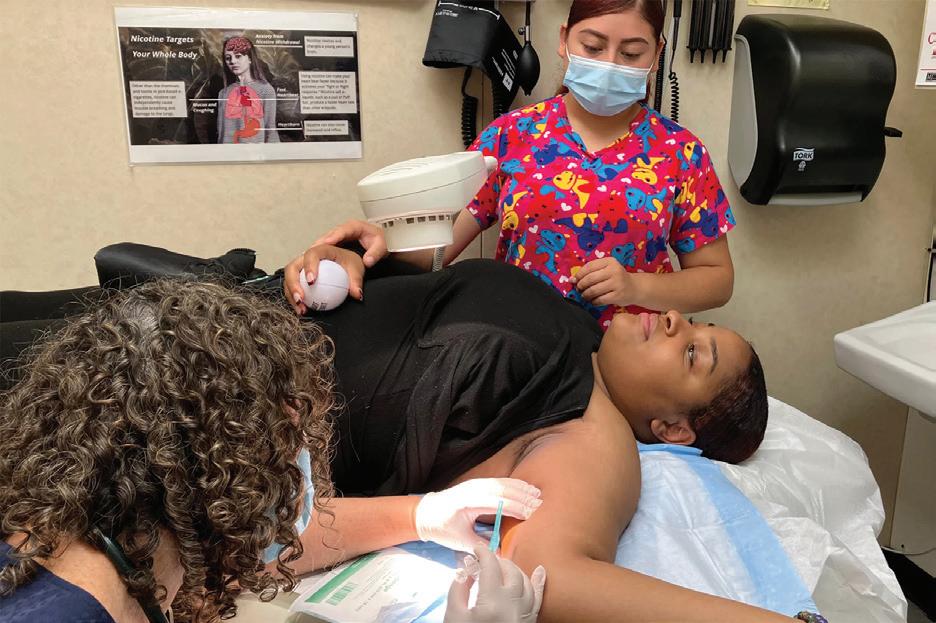
After reviewing the options, Vital decided she wanted a contraceptive implant. During their discussion, Kramer used clear, direct terms, even dropping in phrases students use themselves.
“Who are you talking to these days?” Kramer asked Vital, which is teen-speak for: Who are you having sex with?
“Same person,” Vital replied.
some calming music on her phone, washed her hands and had Vital lie down and raise her left arm over her head.
Association. That group now recommends college clinics do routine pregnancy screenings to identify pregnancies as early as possible, to give students more time to consider their options, and to have legal counsel on call to advise clinicians on allowable practices.
Attorneys might even help advise university health centers about how to have conversations with patients, especially in states like Texas, where local law forbids clinicians from “aiding and abetting” patients who seek abortion care. These new threats — of prosecution or pulled funding — have complicated clinicians’ communication with their collegiate patients.
“So I’m going to be vague with my wording, purposefully,” said Yolanda Nicholson, director of clinical education at the North Carolina Agricultural and Technical State University health center, and chair for the coalition of Historically Black Colleges and Universities of the American College Health Association.
The TechniClinic is a school-based health clinic located across from the football field at Oakland Technical High School in Oakland, California, and run by local nonprofit La Clínica de La Raza. Its staffers are holding “senior send-off” appointments for graduates headed to colleges in the South. (April Dembosky/ KQED)
Physician assistant Andrea Marquez came in to hold Vital’s other hand and offer words of encouragement.
“I’m going to count to three and then you’ll feel a little pinch,” Kramer said, before giving Vital a shot of numbing medication in her tricep area. Then she coached her through a series of deep breaths before inserting the tiny rod under the skin of her upper arm.
The whole procedure took less than 10 minutes, and Vital walked out with a birth control method that will last her up to five years. Now, she said, she can focus on her education and fully experience the new freedoms of college.
“I’m really excited for the growing up part of it,” she said.
Meanwhile, Kramer headed back to her office. She had a list of other patients to check up on, many headed to states that ban abortion. As they pack their books and bed linens for their new dorm rooms, she’s reminding them to also pack a year’s supply of contraception, too.
The “TechniClinic” is a bright-purple building across from the football field and bleachers. The school’s bulldog mascot is painted near the door. On-site, students can get free, confidential birth control consults and screenings for sexually transmitted infections and be back at their desks for fourth-period math.

“You guys have been off and on, off and on,” Kramer said. “How do you feel going forward?”
“Well, now they’re on because he’s going to Texas, too,” Vital revealed with a smile. “He’s going with me.”
The clinic staff started preparing the exam room, so Vital could get the implant right away. Kramer turned on
University-based health centers also are reconsidering their clinical protocols in the wake of the Dobbs v. Jackson Women’s Health Organization Supreme Court ruling that overturned Roe.
In 2020, only 35% of colleges offered on-site IUD insertion and 43% offered contraceptive implant insertion, according to a survey by the American College Health
Nicholson thinks the concept of the senior send-off appointment in the student’s home state is a great one, given that college health centers in Texas and throughout the South have had to adjust their educational approach with students to be more general and “maybe not as specific or targeted as we would have previously done,” to stay aligned with local laws. Out-of-state students are often shocked to discover they don’t have access to the same services as they do at home, she said.
Social Security Overpays Billions to People, Then It Demands the Money Back.
By David Hilzenrath and Jodie Fleischer, Cox Media Group KFF Health NewsJustina Worrell, 47, works part time as a kitchen helper in an Ohio nursing home. She has cerebral palsy, an intellectual disability, and a cardiac condition that required she get an artificial heart valve at age 20.
A year ago, she was earning $862 a month and receiving about $1,065 in monthly Social Security disability benefits when a letter arrived from the federal government. The Social Security Administration had been overpaying her, the letter said, and wanted money back. Within 30 days, it said, she should mail the government a check or money order. For $60,175.90.
“Social Security should be to help people, not to destroy them,” said Addie Arnold, Worrell’s aunt and caregiver.
The Social Security Administration is trying to reclaim billions of dollars from many of the nation’s poorest and most vulnerable — payments it sent them but now says they never should have received.
During the 2022 fiscal year, the agency clawed back $4.7 billion of overpayments, while another $21.6 billion remained outstanding, according to a report by SSA’s inspector general. One consequence is a costly collection effort for the government and a potentially devastating ordeal for the beneficiary.
“We have an overpayment crisis on our hands,” said Rebecca Vallas, a senior fellow at the Century Foundation think tank.
“Overpayments push already struggling beneficiaries even deeper into poverty and hardship, which is directly counterproductive to the goals” of safety-net programs.
The Social Security Administration declined an interview request from KFF Health News and Cox Media Group and would field questions only submitted by email.
The agency declined to say how many people have been asked to repay overpayments.
“We do not report on the number of debtors,” spokesperson Nicole Tiggemann said in a statement.
The agency rejected a May 2022 Freedom of Information Act request for documentation of every overpayment notice sent over several years, and a March 2023 appeal is pending.
Jack Smalligan of the Urban Institute, who has done research on Social Security, estimated that millions of people have received notices saying the agency overpaid them.
Most are on disability, and many cannot afford to repay the government, Smalligan said.
Overpayments can result from Social Security making a mistake or from beneficiaries failing to comply with requirements, intentionally or otherwise. But much of the fault lies within the system — for example:
Rules are complex and hard to follow.
Limits on what beneficiaries can save or own have not been adjusted for inflation in decades.
The Social Security Administration does not have adequate staffing to keep up with its workload, much of which is done by hand.
The system has built-in lags in checking
information such as beneficiaries’ income and relies heavily on data submitted by beneficiaries themselves.
That’s the picture that emerges from agency employees, advocates for the disabled, policy research, SSA publications, reports by the inspector general, records of individual cases, and interviews with more than a dozen people in five states who received repayment notices.
The Social Security Administration is required to be a good steward of the money entrusted to it. That means keeping overpayments to a minimum — and recovering them when they happen, the inspector general has written.
When the agency determines it has overpaid, SSA can ultimately reclaim money from beneficiaries by, for instance, reducing or stopping their monthly benefit payments, garnishing wages, and intercepting federal tax refunds.
The agency tracks its overpayments through quarterly “payment integrity scorecards.” In the most recent scorecard for one Social Security program, the agency said $265 million of overpayments in the 2022 fiscal year were “within the agency’s control.” In other words, the agency blamed itself.
“We were aware of information but failed to take action, or we took incorrect action when the recipient or third-party provided requested information,” the scorecard said.
A much larger source of overpayments in that program, the agency said, was that beneficiaries did not report information, such as changes in their wages or assets.
By the time the agency catches a mistake, years can pass. In the meantime, the beneficiary is likely to have spent the money, and the amount involved can grow to overwhelming proportions.
“We understand getting notice of an overpayment may be unsettling or unclear and we work with people to navigate the overpayment process,” Tiggemann, the agency spokesperson, said by email.
The agency’s payment accuracy is high, Tiggemann said, but given the volume of payments it issues — almost $1.2 trillion in the 2021 fiscal year — “even small error rates add up to substantial improper payment amounts.”
Tiggemann noted that the SSA is developing a program to tap payroll data from outside sources. The agency plans to use that information “when appropriate” to automatically adjust the amounts it pays beneficiaries, she said.
Congress authorized that project almost eight years ago.
Tangled Safety Nets
When people hear “Social Security,” they may think of retirement benefits — the monthly payments the government issues to millions of retired workers and surviving family members under the Old-Age and Survivors Insurance program.
But the Social Security Administration does much more than issue those checks, and its clawbacks for overpayment commonly involve payments under other programs with complicated eligibility requirements.
With certain benefits, how much money — if any — beneficiaries are due each month can change as their circumstances change.
Most of the overpayments involve the Supplemental Security Income program, which provides money to people with little or no income or other resources who are disabled, blind, or at least 65.
In the 2021 fiscal year, more than 7% of that program’s outlays were overpayments, according to the agency’s most recent annual financial report.
Some overpayments involve the Disability Insurance program, which assists disabled workers and their dependents.
Lori Cochran, a beneficiary disabled by multiple sclerosis, said she got tripped up by a life insurance policy she took over from her mother.
After she reviewed her finances with a Social Security representative, she recounted, she received a letter saying she owed $27,000.
“I started having, like, heart palpitations,” she recalled.
Cochran said she didn’t know the insurance policy had a cash value of $4,000.
my elderly age,” she said. Cochran has asked SSA to reconsider. In the meantime, she cashed out the life insurance policy — only to learn that, instead, she could have signed a paper saying she had no intention of cashing it out.
“So now I’m left with no life insurance,” she said. “When I die, my daughter will have no money to bury me.”
A ‘Kafkaesque Minefield’
If beneficiaries believe that an overpayment wasn’t their fault, that the claim is unfair, or that paying the money back would cause hardship, they can ask the SSA to waive repayment. They can also negotiate to repay what they owe gradually.
Cheryl Bates-Harris of the National Disability Rights Network recommended that people who receive overpayment notices appeal, because the information in the notices may be inaccurate.
But trying to resolve an overpayment involves plunging into a “Kafkaesque minefield,” said Darcy Milburn, director of Social Security and health care policy at the Arc, which advocates for people with disabilities.
Another beneficiary named Lori described her journey through the minefield on the condition that her last name be withheld. She provided a copy of an administrative law judge’s ruling in her case.
In 2017, SSA informed her that, since 2000, she had been overpaid $126,612, according to the judge’s ruling.
“I almost threw up when I opened that letter,” she said. “Myself and my husband were like, we were like frantic.”
According to the judge’s ruling, the government based its calculation on her receipt of workers’ compensation benefits as well as disability benefits. She argued that she had told the SSA about the workers’ comp. Lori worked for the U.S. Postal Service until she injured her back.
As her struggle unfolded, the government reduced her monthly benefit checks and then stopped them. She and her husband sold their car and their house and moved from Florida to Georgia, where the cost of living was lower.
She said she ran up credit card debt and called lawyer after lawyer but was told no attorney would help because there was no money to be made from a Social Security case. Then she found one through legal aid.
After six years of battling SSA, including multiple appeals, Lori prevailed. An administrative judge ruled in her favor and wiped away the debt.
Lori had spent her benefit money in the belief she was entitled to it, the judge wrote, and “requiring repayment would be against equity and good conscience.”
A family in Covington, Georgia, had a similar experience.
In 2018, Matt Cooper was shot in the face while working as a police officer there. Since then, he and his wife, Kristen, have depended on Social Security payments to help support their two young children.
“Every decision that we made for our family was based on the benefits that we were supposed to receive,” Kristen Cooper said.
But the Social Security Administration recently demanded the family pay back $30,000 and reduced the children’s benefits. Cooper said the agency failed to correctly include her husband’s workers’ compensation in its calculations.
“Situations like this come up and it just brings back a level of anger and just the need to protect my family,” she said. “The system has definitely let us down.”
Too Late Alex Hubbard, 30, has autism and said he works in a mailroom to keep busy.
“I like to be busy because I don’t want to be bored at home,” he said.
In 2019, Hubbard received an overpayment notice for $11,111.43.
“I’m supposed to report my wages, but I just don’t know how, how it works,” said the Seattle resident.
The agency has cut off his benefits, Hubbard said, but it would have been better if it had stopped them before he owed all that money.
be exasperating, beneficiaries said.
Letters from the agency don’t provide clear explanations, and, if people on the receiving end of overpayment notices can get through to a human, agency employees give inconsistent answers, beneficiaries said.
SSA employees interviewed for this article, speaking as union leaders, said they can relate.
Beneficiaries “struggle getting through to an agency that has all but become non-responsive to the public at this point due to understaffing,” said Jessica LaPointe, a claims specialist in SSA’s Madison, Wisconsin, field office and president of a union council representing Social Security employees.
Tiggemann, the agency spokesperson, cited the challenge of “staffing losses and resource constraints” in her written statement.
In a March 2023 budget message, SSA’s acting commissioner, Kilolo Kijakazi, said SSA was “rebuilding” its workforce after ending the 2022 fiscal year “at our lowest staffing level in over 25 years.”
New workers need a long time to get up to speed, employees said. Complex rules cause trouble for employees and beneficiaries alike.
Members of the public “often struggle to really understand what they’re supposed to report,” LaPointe said.
Rules for the Beneficiaries
Disability benefits are meant for people who can’t do a lot of work.
For disabled people who aren’t blind, the government generally draws a line at earning $1,470 or more per month.
It’s not just bank balances or paycheck amounts and the like that can affect a person’s benefits. In the SSI program, if a family member gives them meals or a place to stay, that can count as “in-kind support.”
Part of the trouble with SSI, critics say, is that limits on the assets that beneficiaries are allowed to hold without forfeiting benefits haven’t been adjusted since 1989. The asset limits stand at $2,000 for individuals and $3,000 for couples.
Had the asset limits been indexed for inflation since 1972, when the program was created, they would be almost five times as much as they are today, according to a July 2023 report by researchers at the Center on Budget and Policy Priorities.
Maintaining eligibility for SSI benefits leaves people with little money to fall back on — let alone to repay a large debt to the government.
A bipartisan group of lawmakers introduced a bill on Sept. 12 to raise the limits.
The SSDI and SSI programs include rules meant to encourage people to work. However, “if beneficiaries attempt work, they are likely to be confronted with an overpayment, and it is likely to be large,” Smalligan and Chantel Boyens of the Urban Institute said in a March 2023 report commissioned by the Social Security Advisory Board.
‘In a Very Bad Place’
Justina Worrell’s aunt and caregiver Addie Arnold, 69, who took her in when she was orphaned as a child, said neither of them has $60,175.90 to repay the government.
The August 2022 letter demanding repayment of that amount was not the first or the last word they have received from the Social Security Administration about possible payment errors. The matter involves two streams of benefits — one from the account of Worrell’s deceased father, and another related to her disability, Arnold said.
“I’ve been confused ever since this started,” she said.
A February 2023 letter from the SSA claiming to explain how “we paid her [Worrell] $7,723.40 too much in benefits” includes difficult-to-decipher data going back to 1996.
The SSA has dropped its claim on some of the more than $60,000 it sought a year ago, but most remains outstanding, Arnold said.
Arnold believes part of the problem is that Worrell’s employer asked her to work additional hours at the nursing home, where she runs a dishwasher and carries trays.
A year ago, Justina Worrell received a letter from the Social Security Administration saying it had overpaid her. Within 30 days, it said, she should mail the government a check or money order for $60,175.90. (COX MEDIA GROUP)
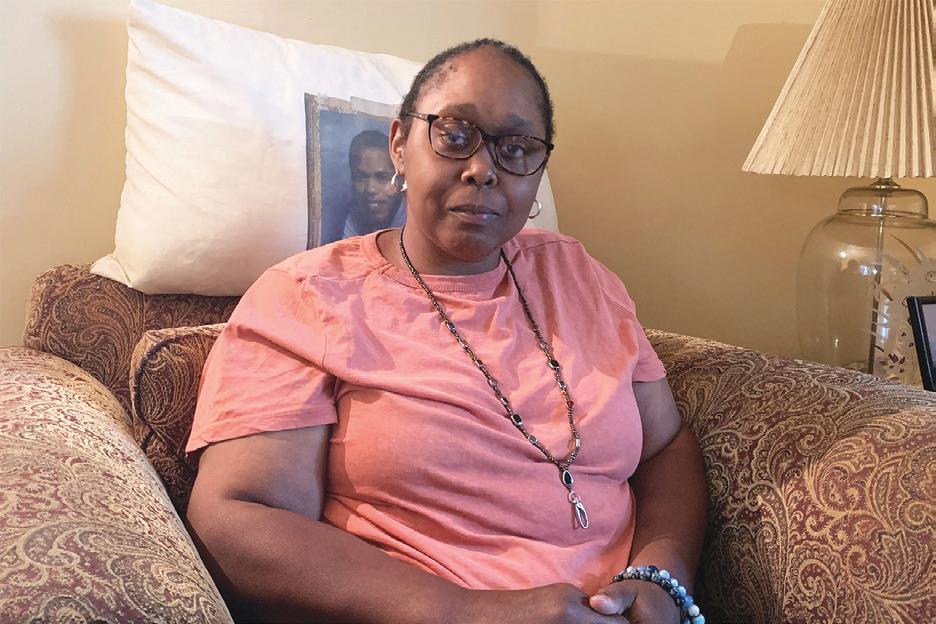
The agency told her that, for every month she held the policy, she wasn’t entitled to any of her $914 monthly benefit, she said. The agency said it would recoup the $27,000 by deducting $91.40 from each of her future checks. At that rate, she would be paying it back “way into
“They should have let me know, like, years back that I owed back that much,” Hubbard said.
Now, the agency is trying to collect the money from his mother, who is unable to manage his benefits since having a stroke, Hubbard said.
Dealing with the Social Security Administration can
“She is so afraid of losing her job that she will do whatever they ask her to do. That is part of her mental state,” Arnold wrote in a letter appealing to the Social Security Administration.
“I truly do hope and pray that she is allowed to stay on SSI,” Arnold wrote, “because she has to continue to live and without it she will be in a very bad place.”

Chargers Hang on Against Vikings
By Earl HeathContributing Sports Writer Justin Herbert completed 40-of-47 passing for 405 yards with three TDs to help lead the Chargers to a 28-24 win over Minnesota. The veteran was sharp all day. Tight end Darnell Parham Jr . had four catches and a career two TD passes.

The game was undecided until Los Angeles linebacker Kenneth Murray came down with it in the end zone for an interception with seven seconds on the clock.
“I just got my hands on it like I was at the park,” said Williams. “I could hear my teammates say ‘stay down’ That was it
get in the endzone and act like you have been there before”
Up by four, head coach Brandon Staley elected to go for it on fourth-and-1 from the L.A. 24 with 1:51 on the clock.
The Vikings didn’t have any timeouts, so a first down would’ve effectively ended the game.
Herbert was steady all day connecting with Mike Williams seven times for 121 yards including a plus a 49-yard touchdown pass. A downer is the Chargers lost receiver Mike Williams for the season with a torn Keenan Allen took over set a Chargers franchise record with 18 catches on 20 targets. He finished with 215 receiving yards.
California Roll Call
By
Contributing Sports Writer Jaydan Daniels LSU and Cajon High School, high completed 20 of 29 passes for 320 yards to help LSU defeat Arkansas 34-31.

CA of Oregon state (3-1) completed 17 of 43 passes for 198 yards in a 38-35 loss to Washington State (4-0) Zevi Eckhaus Culver City High completed 9 of 12 passes (95 yards)to help Byrant University (2-2) defeat Princeton (2-2) 16-13.

to Williams. Kirk Cousins was 32-of-50 passing for 367 yards with three touchdowns and an interception. Jefferson caught seven passes for 149 yards with a TD The Chargers 1-2 will be at home to face the Raiders this week.
Cougars Ward and Utes Ellis Secure Camp Award

By Earl Heath
Contributing Sports Writer Washington State QB Cameron Ward and Utah DE Jonah Elliss were named Walter Camp National FBS Players of the Week, presented by The Heights Group at Morgan Stanley.
Ward completed 28-of-34 pass attempts for 404 yards, four touchdowns with no interceptions adding a rushing touchdown (9 carries, 14 yards) in a 38-35 win over Oregon State. Ward doesn’t care about the accolades he just wants to win in what is potentially the final season for the conference. The Cougars (4-0, 1-0 Pac-12). “If I do my part, teammates do their part, we all play as one, I feel like everything will take care of itself,” Ward said.
On the defensive side Ellis racked up a career-high 10 tackles, including 5.0 tackles for loss and 3.5 sacks in the Utes’ 14-7 victory over UCLA. His 3.5 sacks against the BRUINS ranks second in the FBS in a single-game this season with his 5.0 tackles for loss also tying for second in the FBS. His tackle for loss total ties for fourth-most in school history with his 3.5 sacks also sitting in eighth all-time.
Utah’s defense held UCLA to just nine yards rushing, the third time this season the Utes have held an opponent to under 100 yards on the ground. The Utes rank third in the FBS and first in the Pac-12 in rushing defense (51.0 ypg), also ranking sixth and ninth in the FBS in scoring defense and total defense, leading the league in both.
The Moscow Idaho native is the seventh Ute to earn Walter Camp National Player of the Week honors since 2004 with six of the seven being defensive players. It is Elliss’ first national player of the week honor of his career, also earning Pac-12 Defensive Line Player of the Week for his performance against the Bruins.
Walter Camp is known as “The Father of American football,” first selected an All-America team in 1889. Camp – a former Yale University athlete and football coach – is also credited with developing play from scrimmage, set plays, the numerical assessment of goals and tries and the restriction of play to eleven men per side. The Walter Camp Football Foundation (www.waltercamp.org) – a New Haven-based all-volunteer group – was founded in 1967.
Central Avenue Jazz Festival: Grooving and Moving on The Avenue
By Ricky Richardson Contributing Writer(Los Angeles, CA) The jazz community whole heartily, jubilantly and joyously welcomed the return of the Central Avenue Jazz Festival for an in-person festival, Saturday, September 23, 2023.



The festival has been on hiatus since 2019 due to the pandemic. The Central Avenue Jazz Festival was held virtually since 2020 out of precaution to keep the community safe.
Jazz enthusiasts didn’t mind that the festival was scaled down to a one day celebration. Ever the optimist, there is the possibility and hope of resuming to a two-day festival in the future.
It was common for people to arrive hours early to snag a good seat near the respective outdoor stages. True to form, this tradition returned for this year’s iteration of the Central Avenue Jazz Festival.
The 28th Annual Central Avenue Jazz Festival, a festive outdoor celebration was hosted by Los Angeles City Councilmember Curren D. Price, Jr. (New Ninth District), in conjunction with Coalition for Responsible Development (CRCD), and Concerned Citizens of South Central Los Angeles.

Central Avenue Jazz Festival is popular on many levels. No matter how you look at it, one can say it is a gem, a beloved cultural treasure and/or a signature event for the City of Angels. There is no questioning why jazz fans keep returning to experience one of LA’s most revered event honoring the legacy and contributions of jazz music on the cultural landscape of the West coast.
Central Avenue Jazz Festival is a free-family friendly festival that brought together a large multi-cultural, diverse crowd to celebrate the jazz legends of the past and putting a spotlight on the younger emerging artists that are continuing to carry the torch forward of America’s rich #1 art form: JAZZ!
Everyone is aware and appreciate the fact that music is a universal language. Several thousand lovers of music were in attendance for the 28th Annual Central Avenue Jazz Festival, Saturday, September 23, 2023, from 11:00-7pm. The festival was held on historic Central Avenue between
Vernon Avenue and Martin Luther King Boulevard.
The sweet sounds of Jazz, Blues and Latin jazz performed on three stages filled the air. The Ernie Andrews Stage located on 43rd Street and Central Avenue, Barbara Morrison Stage on 41st and Central Avenue and Dunbar Stage, 42nd Place/and Central Avenue.
It didn’t take long to witness people be-bopping, swaying, swinging, and sashaying to the infectious rhythms heard up and down “the avenue.”
The co-host for the Ernie Andrews stage featured Jose Rizo, a renowned KJAZZ disc jockey, band leader and music producer, and Michael Dolphin, Vice President of the California Jazz Foundation and a music aficionado.
The Central Avenue Jazz Festival got underway with a captivating set provided by Top Shelf Brass Band. They brought and showcased the awesome sounds and traditions of New Orleans Brass Bands. It’s not loss on this writer that the festival opened with this band. It should be noted that New Orleans gave birth to jazz back in the day.
Jimetta Rose, a talented LA native known for her incredible singing, songwriter and poetry was the perfect selection to host the Barbara Morrison Stage.
Jazz America, led by prominent jazz bassist Richard Simon, kicked off the show on the Barbara Morrison Stage. The energetic youth band continued in a New Orleans mode by performing an arrangement of “Joe Avery Blues” aka, “Secondline.” The group did a great job on compositions by jazz legends. They were outstanding with their arrangements of classics selections by Duke Ellington “Things Ain’t What They Used to Be,” “All of Me” by Louis Armstrong, “Take the A Train” Duke Ellington & Billy Strayhorn, “Caravan” composed by Juan Tizol and performed with Duke Ellington. The group honored the legacy of Buddy Collette on the compositions “Veda,” and “April Skies,” with “I Will Remember April” by George Shearing.
The Dunbar Stage located inside of the iconic Dunbar Hotel featured Keith Rice, Ph.D., Historian/ Archivist at the Tom and Ethel Bradley Center (CSUN), and Deborah Swan of the Hefflin Legacy Foundation and the granddaughter of Leon Hefflin, Sr. The two led the crowd in an engaging, educational discussion about the extraordinary but widely known history of Black Angelenos on Central Avenue. The discussion entitled
“The African American Experience on Central Avenue
brought back fond memories from back in the day for some attendees. The Cavalcade of Jazz was also mentioned in the discussion. This year marks the 78th Anniversary of the Inaugural Cavalcade of Jazz at the original Wrigley Field in South Central Los Angeles, September 23, 1945.
The discussion inside the Dunbar Hotel was significant. It was a popular mecca during the height of Central Avenue’s popularity back in the day. The hotel attracted jazz icons like Louis Armstrong, Ella Fitzgerald, Lena Horne and Billie Holiday. Artists like Gerald Wiggins and Art Tatum played in the hotel’s Turban Room piano bar. Duke Ellington’s Band and the Count Basie Orchestra also rehearsed and played in the hotel.
Performers on the Dunbar Stage consisted of the outstanding talents of Los South Central Players, (Youth Musicians Foundation), Yafeu Tyhimba and Joshua Wong.
Legally Bynd added to our enjoyment of the Central Avenue Jazz Festival. They thrilled the crowd with an electrifying set of blues. This proves once again that the blues is a fact of life, as stated by the late great Willie Dixon. The sight of the crowd responding to the band is proof that the blues is alright.
Yuko Mabuchi is a great pianist, arranger, composer, vocalist and scat singer. She was the talk of the festival as she performed a fun, engaging set of original materials as well as popular cover selections. One of the highlights of her set was a cover of “Can’t Hide Love” by Earth, Wind & Fire. Check out the artistry and wizardry of Yuko Mabuchi performing this classic track on YouTube recorded at Vibrato Grill Jazz or a live version performed at this year’s Central Avenue Jazz Festival also on YouTube or other social media platforms. Check out a live performance of this prolific and phenomenal pianist whenever the opportunity presents itself.
Yosmel Montejo & LA Caliente added the spicy flavors of Latin Jazz and Salsa to the festivities. Salsa dancers couldn’t have been more delighted dancing to the contagious and infectious soundtrack during his set. The crowd and I were in for a treat. Hubert Laws premier flute player and winner of the 2011 National Endowment for the Arts (NEA) Master award (the highest honor the nation bestows of jazz artists). Hubert Laws with special guest Eloise Laws and Debra Laws put on a show stopping, crowd pleasing set of selections from his catalog as well as his collaborations with other musicians.
Singer, songwriters Elaine Gibbs liven up the proceedings during her time to shine in the spotlight. She delivered a great performance of original and classic jazz selections.
The festival featured a line-up of top notch performers. A highlight included a headlining set by five-time Grammy Award winner Billy Childs. Billy Childs is considered one of the foremost American composers of his era. Billy Childs Quartet performance was superb featuring trumpeter Sean Jones.
Performance on the Ernie Andrews Stage concluded with the Central Avenue Jazz Experience. This group featured an All-star roster of jazz musicians and leaders in their own right. Ryan Porter, Brandon Coleman, Cameron Graves, Ben Williams, Tony Austin and special guest singer, songwriter Toni Scruggs. These talented musicians individually and collectively, have blazed a new trail in jazz. Boogaloo Assassins closed out the day on the Barbara Morrison Stage. Boogaloo Assassins is a 13-piece Latin soul and Salsa based in Los Angeles. They are three-time recipients of the “Best Latin Band” by OC Weekly Music Awards. Salseros and other attendees left the festival with an extra pep in their step, a little cha cha cha and Salsa two steps.
Attendees at this Central Jazz Festival inevitably worked up an appetite. They only need to venture over to Jazz Flavor Court for an array of food and beverage vendors. They were provided with a diverse selection of culinary experiences. Crowd favorites and new eateries served up a smorgasbord of cuisines to satisfy everyone’s palates.
Four pavilions complemented and enhanced the jazz festival experience for all in attendance. Youth programming provided games and arts and crafts; health and wellness provided a wide range of healthcare services. The art pavilion curated by La Mancha had a unique cultural art exhibit featuring cutting edge artwork from renowned local artists. Featured art exhibit LP Aekili Ross entitled “Giant Steps.” Additional artists on site featured Buena Johnson and participating artists Bert Ross, EnkOne, Leo Aguiree, Mohammed Mubarak, Ron Zeno, Skira Martinez of Cielo Galleries, Wendell Wiggins, X. Darvi and Shelton Gillis. The public Services pavilion provided valuable information and resources were available to residents of the greater Los Angeles area.

